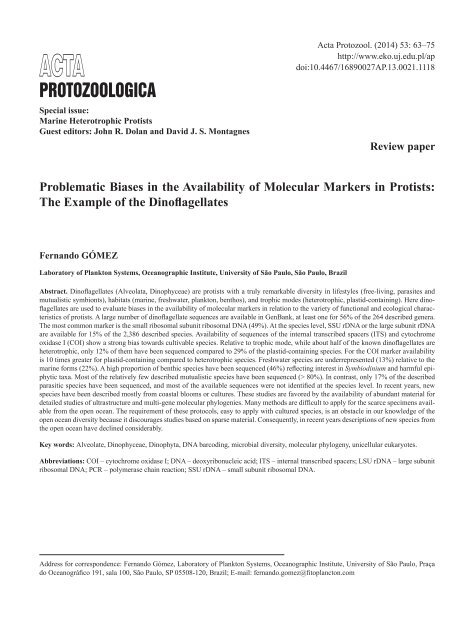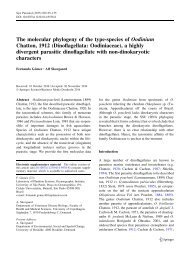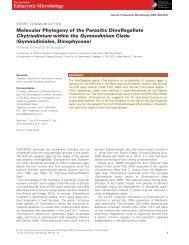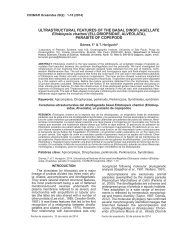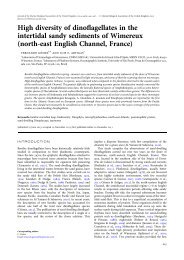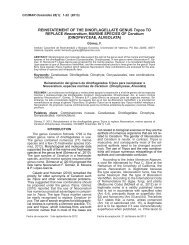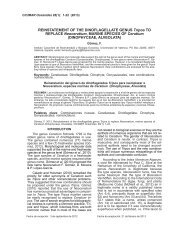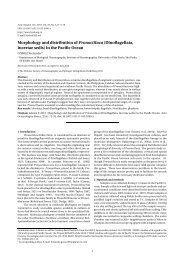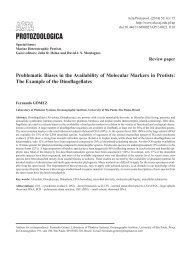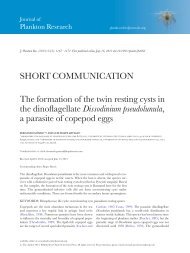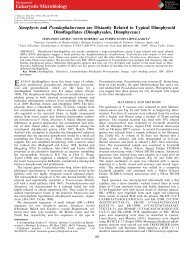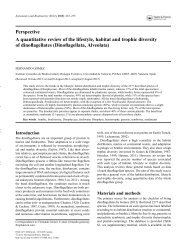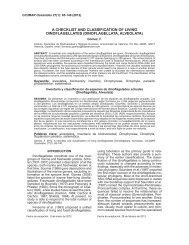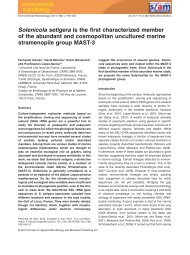Problematic Biases in the Availability of Molecular Markers in Protists: The Example of the Dinoflagellates
Dinoflagellates (Alveolata, Dinophyceae) are protists with a truly remarkable diversity in lifestyles (free-living, parasites and mutualistic symbionts), habitats (marine, freshwater, plankton, benthos), and trophic modes (heterotrophic, plastid-containing). Here dinoflagellates are used to evaluate biases in the availability of molecular markers in relation to the variety of functional and ecological characteristics of protists. A large number of dinoflagellate sequences are available in GenBank, at least one for 56% of the 264 described genera. The most common marker is the small ribosomal subunit ribosomal DNA (49%). At the species level, SSU rDNA or the large subunit rDNA are available for 15% of the 2,386 described species. Availability of sequences of the internal transcribed spacers (ITS) and cytochrome oxidase I (COI) show a strong bias towards cultivable species. Relative to trophic mode, while about half of the known dinoflagellates are heterotrophic, only 12% of them have been sequenced compared to 29% of the plastid-containing species. For the COI marker availability is 10 times greater for plastid-containing compared to heterotrophic species. Freshwater species are underrepresented (13%) relative to the marine forms (22%). A high proportion of benthic species have been sequenced (46%) reflecting interest in Symbiodinium and harmful epiphytic taxa. Most of the relatively few described mutualistic species have been sequenced (> 80%). In contrast, only 17% of the described parasitic species have been sequenced, and most of the available sequences were not identified at the species level. In recent years, new species have been described mostly from coastal blooms or cultures. These studies are favored by the availability of abundant material for detailed studies of ultrastructure and multi-gene molecular phylogenies. Many methods are difficult to apply for the scarce specimens available from the open ocean. The requirement of these protocols, easy to apply with cultured species, is an obstacle in our knowledge of the open ocean diversity because it discourages studies based on sparse material. Consequently, in recent years descriptions of new species from the open ocean have declined considerably
Dinoflagellates (Alveolata, Dinophyceae) are protists with a truly remarkable diversity in lifestyles (free-living, parasites and
mutualistic symbionts), habitats (marine, freshwater, plankton, benthos), and trophic modes (heterotrophic, plastid-containing). Here dinoflagellates
are used to evaluate biases in the availability of molecular markers in relation to the variety of functional and ecological characteristics
of protists. A large number of dinoflagellate sequences are available in GenBank, at least one for 56% of the 264 described genera.
The most common marker is the small ribosomal subunit ribosomal DNA (49%). At the species level, SSU rDNA or the large subunit rDNA
are available for 15% of the 2,386 described species. Availability of sequences of the internal transcribed spacers (ITS) and cytochrome
oxidase I (COI) show a strong bias towards cultivable species. Relative to trophic mode, while about half of the known dinoflagellates are
heterotrophic, only 12% of them have been sequenced compared to 29% of the plastid-containing species. For the COI marker availability
is 10 times greater for plastid-containing compared to heterotrophic species. Freshwater species are underrepresented (13%) relative to the
marine forms (22%). A high proportion of benthic species have been sequenced (46%) reflecting interest in Symbiodinium and harmful epiphytic
taxa. Most of the relatively few described mutualistic species have been sequenced (> 80%). In contrast, only 17% of the described
parasitic species have been sequenced, and most of the available sequences were not identified at the species level. In recent years, new
species have been described mostly from coastal blooms or cultures. These studies are favored by the availability of abundant material for
detailed studies of ultrastructure and multi-gene molecular phylogenies. Many methods are difficult to apply for the scarce specimens available
from the open ocean. The requirement of these protocols, easy to apply with cultured species, is an obstacle in our knowledge of the
open ocean diversity because it discourages studies based on sparse material. Consequently, in recent years descriptions of new species from
the open ocean have declined considerably
You also want an ePaper? Increase the reach of your titles
YUMPU automatically turns print PDFs into web optimized ePapers that Google loves.
ACTA<br />
PROTOZOOLOGICA<br />
Special issue:<br />
Mar<strong>in</strong>e Heterotrophic <strong>Protists</strong><br />
Guest editors: John R. Dolan and David J. S. Montagnes<br />
Acta Protozool. (2014) 53: 63–75<br />
http://www.eko.uj.edu.pl/ap<br />
doi:10.4467/16890027AP.13.0021.1118<br />
Review paper<br />
<strong>Problematic</strong> <strong>Biases</strong> <strong>in</strong> <strong>the</strong> <strong>Availability</strong> <strong>of</strong> <strong>Molecular</strong> <strong>Markers</strong> <strong>in</strong> <strong>Protists</strong>:<br />
<strong>The</strong> <strong>Example</strong> <strong>of</strong> <strong>the</strong> D<strong>in</strong><strong>of</strong>lagellates<br />
Fernando GÓMEZ<br />
Laboratory <strong>of</strong> Plankton Systems, Oceanographic Institute, University <strong>of</strong> São Paulo, São Paulo, Brazil<br />
Abstract. D<strong>in</strong><strong>of</strong>lagellates (Alveolata, D<strong>in</strong>ophyceae) are protists with a truly remarkable diversity <strong>in</strong> lifestyles (free-liv<strong>in</strong>g, parasites and<br />
mutualistic symbionts), habitats (mar<strong>in</strong>e, freshwater, plankton, benthos), and trophic modes (heterotrophic, plastid-conta<strong>in</strong><strong>in</strong>g). Here d<strong>in</strong><strong>of</strong>lagellates<br />
are used to evaluate biases <strong>in</strong> <strong>the</strong> availability <strong>of</strong> molecular markers <strong>in</strong> relation to <strong>the</strong> variety <strong>of</strong> functional and ecological characteristics<br />
<strong>of</strong> protists. A large number <strong>of</strong> d<strong>in</strong><strong>of</strong>lagellate sequences are available <strong>in</strong> GenBank, at least one for 56% <strong>of</strong> <strong>the</strong> 264 described genera.<br />
<strong>The</strong> most common marker is <strong>the</strong> small ribosomal subunit ribosomal DNA (49%). At <strong>the</strong> species level, SSU rDNA or <strong>the</strong> large subunit rDNA<br />
are available for 15% <strong>of</strong> <strong>the</strong> 2,386 described species. <strong>Availability</strong> <strong>of</strong> sequences <strong>of</strong> <strong>the</strong> <strong>in</strong>ternal transcribed spacers (ITS) and cytochrome<br />
oxidase I (COI) show a strong bias towards cultivable species. Relative to trophic mode, while about half <strong>of</strong> <strong>the</strong> known d<strong>in</strong><strong>of</strong>lagellates are<br />
heterotrophic, only 12% <strong>of</strong> <strong>the</strong>m have been sequenced compared to 29% <strong>of</strong> <strong>the</strong> plastid-conta<strong>in</strong><strong>in</strong>g species. For <strong>the</strong> COI marker availability<br />
is 10 times greater for plastid-conta<strong>in</strong><strong>in</strong>g compared to heterotrophic species. Freshwater species are underrepresented (13%) relative to <strong>the</strong><br />
mar<strong>in</strong>e forms (22%). A high proportion <strong>of</strong> benthic species have been sequenced (46%) reflect<strong>in</strong>g <strong>in</strong>terest <strong>in</strong> Symbiod<strong>in</strong>ium and harmful epiphytic<br />
taxa. Most <strong>of</strong> <strong>the</strong> relatively few described mutualistic species have been sequenced (> 80%). In contrast, only 17% <strong>of</strong> <strong>the</strong> described<br />
parasitic species have been sequenced, and most <strong>of</strong> <strong>the</strong> available sequences were not identified at <strong>the</strong> species level. In recent years, new<br />
species have been described mostly from coastal blooms or cultures. <strong>The</strong>se studies are favored by <strong>the</strong> availability <strong>of</strong> abundant material for<br />
detailed studies <strong>of</strong> ultrastructure and multi-gene molecular phylogenies. Many methods are difficult to apply for <strong>the</strong> scarce specimens available<br />
from <strong>the</strong> open ocean. <strong>The</strong> requirement <strong>of</strong> <strong>the</strong>se protocols, easy to apply with cultured species, is an obstacle <strong>in</strong> our knowledge <strong>of</strong> <strong>the</strong><br />
open ocean diversity because it discourages studies based on sparse material. Consequently, <strong>in</strong> recent years descriptions <strong>of</strong> new species from<br />
<strong>the</strong> open ocean have decl<strong>in</strong>ed considerably.<br />
Key words: Alveolate, D<strong>in</strong>ophyceae, D<strong>in</strong>ophyta, DNA barcod<strong>in</strong>g, microbial diversity, molecular phylogeny, unicellular eukaryotes.<br />
Abbreviations: COI – cytochrome oxidase I; DNA – deoxyribonucleic acid; ITS – <strong>in</strong>ternal transcribed spacers; LSU rDNA – large subunit<br />
ribosomal DNA; PCR – polymerase cha<strong>in</strong> reaction; SSU rDNA – small subunit ribosomal DNA.<br />
Address for correspondence: Fernando Gómez, Laboratory <strong>of</strong> Plankton Systems, Oceanographic Institute, University <strong>of</strong> São Paulo, Praça<br />
do Oceanográfico 191, sala 100, São Paulo, SP 05508-120, Brazil; E-mail: fernando.gomez@fitoplancton.com
64<br />
F. Gómez<br />
INTRODUCTION<br />
<strong>The</strong> use <strong>of</strong> molecular methods has played a major<br />
role <strong>in</strong> advanc<strong>in</strong>g our understand<strong>in</strong>g <strong>of</strong> microbial diversity.<br />
<strong>The</strong> technique <strong>of</strong> DNA taxonomy or DNA barcod<strong>in</strong>g,<br />
a short standardized stretch <strong>of</strong> DNA sequence,<br />
may be used to identify species (Blaxter 2004, Miller<br />
2007). <strong>The</strong> most extended molecular markers <strong>in</strong> DNA<br />
taxonomy are <strong>the</strong> mitochondrial markers [cytochrome<br />
oxidase I (COI), cytochrome oxidase B, etc.], and <strong>the</strong><br />
nuclear markers <strong>of</strong> <strong>the</strong> ribosomal DNA operon. COI is<br />
<strong>the</strong> most extended marker for <strong>the</strong> DNA barcod<strong>in</strong>g <strong>in</strong> animals<br />
(Hebert et al. 2003), and macroalgae (Le Gall and<br />
Saunders 2010), while it is considered too conserved<br />
for higher plants (Newmaster et al. 2006). <strong>The</strong> utility<br />
<strong>of</strong> COI for DNA barcod<strong>in</strong>g is controversial <strong>in</strong> protists,<br />
with less documented attempts and variable success<br />
(Ehara et al. 2000, Evans et al. 2007). It has been po<strong>in</strong>ted<br />
out that a barcod<strong>in</strong>g system based on mitochondrial<br />
markers such as COI or cytochrome oxidase B will not<br />
provide a universal solution to protist identifications<br />
because anaerobic species lack mitochondria (Henze<br />
and Mart<strong>in</strong> 2003).<br />
<strong>The</strong> o<strong>the</strong>r ma<strong>in</strong> group <strong>of</strong> markers for phylogenetical<br />
analysis is <strong>the</strong> ribosomal DNA operon. <strong>The</strong>se genes are<br />
present throughout <strong>the</strong> liv<strong>in</strong>g world and <strong>the</strong>y evolve relatively<br />
slowly, both <strong>of</strong> <strong>the</strong>se traits enable comparison <strong>of</strong><br />
distantly related organisms. <strong>The</strong> repetitive arrangement<br />
with<strong>in</strong> <strong>the</strong> genome provides enough amounts <strong>of</strong> template<br />
DNA for PCR, even <strong>in</strong> smallest organisms (Hillis<br />
and Dixon 1991). <strong>The</strong>se markers are <strong>the</strong> 18S rDNA or<br />
small subunit ribosomal DNA (SSU rDNA), <strong>the</strong> 28S<br />
rDNA or large subunit rDNA (LSU rDNA), <strong>the</strong> <strong>in</strong>ternal<br />
transcribed spacers 1 (ITS1) and 2 (ITS2) regions,<br />
and <strong>the</strong> 5.8S rDNA. <strong>The</strong>re are o<strong>the</strong>r markers used <strong>in</strong><br />
molecular phylogenies, ma<strong>in</strong>ly based on prote<strong>in</strong> cod<strong>in</strong>g<br />
genes: α- and β-tubul<strong>in</strong>, act<strong>in</strong>, cytochrome oxidase B,<br />
heat-shock prote<strong>in</strong> 90, and o<strong>the</strong>rs (Pochon et al. 2012).<br />
<strong>The</strong>se alternative markers are not well represented <strong>in</strong><br />
public databases. <strong>The</strong> vast majority <strong>of</strong> <strong>the</strong> sequences<br />
are from photosyn<strong>the</strong>tic stra<strong>in</strong>s available <strong>in</strong> culture<br />
collections and <strong>the</strong> phylogenies do not <strong>in</strong>clude enough<br />
taxa to be widely useful.<br />
<strong>The</strong> d<strong>in</strong><strong>of</strong>lagellates are an ancient alveolate group<br />
<strong>of</strong> about ~ 2,400 extant described species and o<strong>the</strong>r<br />
~ 2,000 fossil species (Taylor 1987, Gómez 2012a).<br />
D<strong>in</strong><strong>of</strong>lagellates possess numerous unique morphological<br />
and ultrastructural attributes (Hackett et al. 2004)<br />
such as huge genome sizes <strong>of</strong> 0.2–200 pg DNA per cell<br />
(LaJeunesse et al. 2005, L<strong>in</strong> 2006) and many genes<br />
with high copy numbers (Rowan et al. 1996). This<br />
feature has favored s<strong>in</strong>gle-cell sequenc<strong>in</strong>g (Lynn and<br />
P<strong>in</strong>heiro 2009). <strong>The</strong> s<strong>in</strong>gle-cell PCR technique allows<br />
sequenc<strong>in</strong>g <strong>of</strong> rare uncultured species, <strong>in</strong>clud<strong>in</strong>g those<br />
found only <strong>in</strong> low abundances, from different habitats<br />
and ecological niches.<br />
While <strong>the</strong> size <strong>of</strong> <strong>the</strong> d<strong>in</strong><strong>of</strong>lagellate genome has, to<br />
date, prevented whole genome sequenc<strong>in</strong>g projects,<br />
several genes have been sequenced. <strong>The</strong> first sequence<br />
<strong>of</strong> a d<strong>in</strong><strong>of</strong>lagellate gene was <strong>the</strong> 5S rDNA <strong>of</strong> Cryp<strong>the</strong>cod<strong>in</strong>ium<br />
cohnii (H<strong>in</strong>nebusch et al. 1981). <strong>The</strong> most<br />
extensive markers are parts <strong>of</strong> <strong>the</strong> rDNA array, <strong>the</strong> SSU<br />
rDNA (McNally et al. 1994, Saunders et al. 1997), LSU<br />
rDNA (Lenaers et al. 1991, Daugbjerg et al. 2000), and<br />
<strong>the</strong> ITS regions (LaJeunesse 2001). <strong>The</strong> differences <strong>in</strong><br />
<strong>the</strong> evolutionary rates <strong>in</strong> <strong>the</strong> ribosomal genes <strong>of</strong> d<strong>in</strong><strong>of</strong>lagellates,<br />
especially SSU rDNA and also <strong>in</strong> <strong>the</strong> doma<strong>in</strong>s<br />
<strong>of</strong> <strong>the</strong> LSU rDNA, has yielded phylogenetic trees<br />
with a characteristic structure: a large group <strong>of</strong> short<br />
branched sequences, <strong>the</strong> so-called Gymnod<strong>in</strong>iales, Prorocentrales<br />
and Perid<strong>in</strong>iales complex (GPP complex),<br />
and a group with longer branches <strong>in</strong>clud<strong>in</strong>g Gonyaulacales<br />
and o<strong>the</strong>r taxa (Saunders et al. 1997, Saldarriaga<br />
et al. 2004).<br />
<strong>The</strong> phylogenies based on SSU and LSU rDNA<br />
markers do not resolve <strong>the</strong> relations between <strong>the</strong> ma<strong>in</strong><br />
classical orders due to extremely low divergence rates.<br />
As a general rule, <strong>the</strong> SSU rDNA marker tends to be suitable<br />
to <strong>in</strong>fer phylogenies at family or genus level while<br />
<strong>the</strong> LSU rDNA marker is more effective <strong>in</strong> discrim<strong>in</strong>at<strong>in</strong>g<br />
species. <strong>The</strong> ITS marker is present <strong>in</strong> multiple dist<strong>in</strong>ct<br />
copies, with <strong>the</strong> possibility that high <strong>in</strong>tra- and <strong>in</strong>tergenomic<br />
variation and <strong>the</strong> presence <strong>of</strong> <strong>in</strong>dels that can<br />
make direct sequenc<strong>in</strong>g challeng<strong>in</strong>g and alignment difficult.<br />
It is really difficult to design a d<strong>in</strong><strong>of</strong>lagellate-specific<br />
primer set to amplify <strong>the</strong> ITS region for all or most<br />
<strong>of</strong> <strong>the</strong> d<strong>in</strong><strong>of</strong>lagellate taxa (Litaker et al. 2007, Pochon et<br />
al. 2012, Stern et al. 2012). <strong>The</strong> COI marker can be useful<br />
for identify<strong>in</strong>g s<strong>in</strong>gle cells or monospecific cultures<br />
and successfully used to dist<strong>in</strong>guish different genotypes<br />
<strong>of</strong> <strong>the</strong> coral symbiont Symbiod<strong>in</strong>ium (Takabayashi et al.<br />
2004). However, its utility as a d<strong>in</strong><strong>of</strong>lagellate barcode<br />
is questionable due to repetitive failure <strong>of</strong> <strong>the</strong> primer<br />
sets to amplify all d<strong>in</strong><strong>of</strong>lagellate species <strong>in</strong> natural assemblages,<br />
and <strong>the</strong> lower resolv<strong>in</strong>g power with generally<br />
lower bootstrap support than o<strong>the</strong>r genes exam<strong>in</strong>ed<br />
(Zhang et al. 2007, L<strong>in</strong> et al. 2009). Plastid genes have<br />
not been used to <strong>in</strong>fer <strong>the</strong> phylogeny <strong>of</strong> d<strong>in</strong><strong>of</strong>lagellates
<strong>Molecular</strong> <strong>Markers</strong> <strong>in</strong> D<strong>in</strong><strong>of</strong>lagellata<br />
65<br />
for several reasons. For example, <strong>the</strong>y are only present<br />
<strong>in</strong> about 50% <strong>of</strong> taxa, and <strong>in</strong> those species, <strong>the</strong>y may<br />
have been lost and ga<strong>in</strong>ed on multiple occasions (Saldarriaga<br />
et al. 2001, Hackett et al. 2004).<br />
D<strong>in</strong><strong>of</strong>lagellates exhibit extreme diversity <strong>in</strong> almost<br />
all ecological characteristics, <strong>in</strong>clud<strong>in</strong>g <strong>the</strong>ir modes <strong>of</strong><br />
nutrition (heterotrophic, plastid-conta<strong>in</strong><strong>in</strong>g), habitat<br />
distribution (mar<strong>in</strong>e, freshwater, plankton, benthos),<br />
and lifestyle (free-liv<strong>in</strong>g species, parasites and mutualistic<br />
symbionts) (Taylor 1987, Gómez 2012b). For<br />
<strong>the</strong>se reasons, d<strong>in</strong><strong>of</strong>lagellates are an ideal case to evaluate<br />
biases <strong>in</strong> <strong>the</strong> availability <strong>of</strong> <strong>the</strong> molecular markers <strong>in</strong><br />
relation to functional and ecological characteristics <strong>of</strong><br />
protist taxa. It appears that <strong>the</strong> advances <strong>in</strong> <strong>the</strong> molecular<br />
phylogeny show a high taxonomic selectivity, and<br />
may even have adverse consequences for <strong>the</strong> knowledge<br />
<strong>of</strong> certa<strong>in</strong> groups.<br />
MATERIALS AND METHODS<br />
<strong>The</strong> primary source used was <strong>the</strong> checklist <strong>of</strong> liv<strong>in</strong>g d<strong>in</strong><strong>of</strong>lagellates<br />
by Gómez (2012a) that listed 2,377 described species. Twelve<br />
o<strong>the</strong>r species have been added (recently described or miss<strong>in</strong>g <strong>in</strong><br />
<strong>the</strong> previous checklist). Each species was classified with regard to<br />
distribution and habitat (mar<strong>in</strong>e or freshwater, and planktonic or<br />
benthic), lifestyle (free-liv<strong>in</strong>g, parasitic or mutualistic symbionts)<br />
as well as trophic modes (heterotrophic or plastid-conta<strong>in</strong><strong>in</strong>g) follow<strong>in</strong>g<br />
<strong>the</strong> criteria reported <strong>in</strong> Gómez (2012b). <strong>The</strong> taxa identified<br />
at <strong>the</strong> species level (b<strong>in</strong>omials) were surveyed <strong>in</strong> <strong>in</strong>ternational nucleotide<br />
sequence databases (DDBJ/EMBL/GenBank), and labeled<br />
accord<strong>in</strong>g to <strong>the</strong> availability <strong>of</strong> at least one nucleotide sequence <strong>of</strong><br />
<strong>the</strong> most extensive molecular markers (SSU, LSU, ITS and COI).<br />
<strong>The</strong> database is provided as supplementary material (supplementary<br />
material Table S1). <strong>The</strong> alternative molecular markers (act<strong>in</strong>, α- and<br />
β-tubul<strong>in</strong>, cytochrome oxidase B, heat-shock prote<strong>in</strong> 90, etc.) were<br />
largely underrepresented, and <strong>the</strong> vast majority <strong>of</strong> <strong>the</strong> sequences<br />
were from photosyn<strong>the</strong>tic stra<strong>in</strong>s available <strong>in</strong> culture collections.<br />
Almost all <strong>the</strong> species names reported <strong>in</strong> GenBank were represented<br />
by at least one nucleotide sequence <strong>of</strong> <strong>the</strong> SSU, LSU, ITS or COI<br />
markers, while <strong>the</strong> only b<strong>in</strong>omials lack<strong>in</strong>g any <strong>of</strong> <strong>the</strong>se markers<br />
were Symbiod<strong>in</strong>ium fittii (only microsatellite sequence available),<br />
Prorocentrum nanum (only cytochrome oxidase B), and Pyrocystis<br />
fusiformis (only luciferase).<br />
It is <strong>of</strong>ten difficult to determ<strong>in</strong>ate whe<strong>the</strong>r <strong>the</strong> b<strong>in</strong>omials reported<br />
<strong>in</strong> GenBank were correctly identified. <strong>The</strong>re is no formal<br />
documentation <strong>of</strong> taxonomic identifications (e.g. photographs, collection<br />
sources for cultures, or <strong>in</strong>formation on <strong>the</strong> <strong>in</strong>dividual who<br />
performed identifications). Some sequences <strong>of</strong> o<strong>the</strong>r groups are erroneously<br />
reported under d<strong>in</strong><strong>of</strong>lagellate names [Exuviaella pusilla<br />
(#DQ388459) or Prorocentrum m<strong>in</strong>imum (#EF017804)]. It can be<br />
assumed that <strong>the</strong> cultures were contam<strong>in</strong>ated, and <strong>the</strong> authors did not<br />
first check <strong>the</strong> BLAST (Basic Local Alignment Search Tool) entries<br />
<strong>of</strong> <strong>the</strong>ir sequences. For example, a sequence <strong>of</strong> Neoceratium furca<br />
(#AY027908) corresponds with an Alexandrium species. In addition<br />
to contam<strong>in</strong>ations, culture collections are sometimes subjected<br />
to mislabel<strong>in</strong>g or misidentifications. For example sequences <strong>of</strong> <strong>the</strong><br />
armoured genus Heterocapsa were named under <strong>the</strong> unarmoured<br />
genus Gymnod<strong>in</strong>ium [#Gymnod<strong>in</strong>ium sp. CCMP424 (#EF492492)<br />
or Gymnod<strong>in</strong>ium sp. UTEX1653 (#EF492494)] (see additional examples<br />
<strong>in</strong> Stern et al. 2012). Accord<strong>in</strong>g to GenBank <strong>the</strong> sequence<br />
<strong>of</strong> Perid<strong>in</strong>ium centenniale was restricted to <strong>the</strong> cytochrome oxidase<br />
B gene. <strong>The</strong> SSU rDNA sequences <strong>of</strong> this species may be under<br />
o<strong>the</strong>r names [D<strong>in</strong>ophyceae sp. CCAC0002 (#EF058236), Glenod<strong>in</strong>ium<br />
<strong>in</strong>aequale (#EF058237)]. <strong>The</strong>re were sequences from cultures<br />
identified as ‘Scrippsiella <strong>in</strong>ulfa’ that may correspond to Calcigonellum<br />
<strong>in</strong>fula. <strong>The</strong> misspell<strong>in</strong>g <strong>of</strong> <strong>the</strong> epi<strong>the</strong>t did not facilitate<br />
<strong>the</strong> identification <strong>of</strong> <strong>the</strong> correct species name. In o<strong>the</strong>r cases, <strong>the</strong>re<br />
is no documentation to resolve doubts. <strong>The</strong> epi<strong>the</strong>ts <strong>of</strong> ‘Prorocentrum<br />
donggang’ or ‘P. ta<strong>in</strong>an’ resemble valid b<strong>in</strong>omials. However,<br />
<strong>the</strong>se species have not been formally described and <strong>the</strong> apparent<br />
epi<strong>the</strong>t may refer to places where <strong>the</strong> cells were isolated <strong>in</strong> Taiwan.<br />
‘Gymnod<strong>in</strong>ium falcatum’ (#AY320049) has been never formally<br />
described. It may refer to Gyrod<strong>in</strong>ium faltacum. <strong>The</strong> species<br />
is named Pseliod<strong>in</strong>ium vaubanii, one <strong>of</strong> its synonyms, because <strong>the</strong><br />
morphology and <strong>the</strong> sequence did not branch with Gymnod<strong>in</strong>ium or<br />
Gyrod<strong>in</strong>ium sensu stricto. <strong>The</strong>se are examples <strong>of</strong> <strong>the</strong> difficulties to<br />
assign a proper species name to <strong>the</strong> sequences.<br />
RESULTS<br />
Overview <strong>of</strong> <strong>the</strong> availability <strong>of</strong> <strong>the</strong> ma<strong>in</strong> molecular<br />
markers<br />
To date, for <strong>the</strong> 264 described extant genera, at least<br />
one nucleotide sequence is available <strong>in</strong> GenBank for<br />
149 (56%) <strong>of</strong> d<strong>in</strong><strong>of</strong>lagellate genera (Table 1). <strong>The</strong> most<br />
common marker is SSU rDNA for 131 genera (49%),<br />
LSU rDNA for 108 genera (41%), ITS for 69 genera<br />
(26%), and COI for 48 genera (18%). At least one nucleotide<br />
sequence identified at <strong>the</strong> species level is available<br />
for 493 d<strong>in</strong><strong>of</strong>lagellates (Table 1). This corresponded<br />
to 20% <strong>of</strong> <strong>the</strong> 2,386 extant described species. <strong>The</strong><br />
SSU rDNA marker is available for 345 species (14% <strong>of</strong><br />
2,386), LSU for 358 species (15%), ITS for 184 species<br />
(7%), and COI for 97 species (4%).<br />
Among <strong>the</strong> most speciose d<strong>in</strong><strong>of</strong>lagellate genera<br />
(> 11 species per genus), <strong>the</strong> highest percentage <strong>of</strong><br />
sequenced species concerns Gambierdiscus (100%),<br />
Symbiod<strong>in</strong>ium (87%, only lack<strong>in</strong>g S. tridacnorum), and<br />
Alexandrium (77%), followed by o<strong>the</strong>r mar<strong>in</strong>e plastid-conta<strong>in</strong><strong>in</strong>g<br />
genera such as Karenia, Karlod<strong>in</strong>ium,<br />
Blastod<strong>in</strong>ium, Heterocapsa, Prorocentrum and Scrippsiella,<br />
with sequences <strong>of</strong> more than 40% <strong>of</strong> <strong>the</strong> species<br />
(Fig. 1). All <strong>the</strong>se taxa are available <strong>in</strong> culture, with<br />
<strong>the</strong> exception <strong>of</strong> <strong>the</strong> parasite Blastod<strong>in</strong>ium. <strong>The</strong> genus
66<br />
F. Gómez<br />
Table 1. Number and percentage <strong>of</strong> d<strong>in</strong><strong>of</strong>lagellate genera and species with at least one nucleotide sequence available <strong>in</strong> DDBJ/EMBL/<br />
GenBank <strong>in</strong> January 2013. SSU – small subunit rDNA, LSU – large subunit rDNA, ITS – <strong>in</strong>ternal transcribed spacers, COI – cytochrome<br />
oxidase I, CHL – plastid-conta<strong>in</strong><strong>in</strong>g, HET – heterotrophic, FRE – free-liv<strong>in</strong>g, PAR – parasite, SYM – mutualistic symbiont, MAR – mar<strong>in</strong>e,<br />
FS – freshwater/ cont<strong>in</strong>ental, PLK – plankton, BEN – benthos.<br />
Total Any marker SSU LSU ITS COI<br />
Genera 264 149 (56%) 131 (49%) 108 (41%) 69 (26%) 48 (18%)<br />
Species 2,386 493 (20%) 345 (14%) 358 (15%) 184 (7%) 97 (4%)<br />
CHL 1,204 348 (29%) 237 (20%) 269 (22%) 161 (13%) 89 (7%)<br />
HET 1,182 145 (12%) 108 (10%) 89 (7%) 23 (2%) 8 (0.7%)<br />
FRE 2,200 447 (20%) 307 (14%) 331 (15%) 156 (7%) 91 (4%)<br />
PAR 165 29 (17%) 29 (17%) 18 (11%) 18 (11%) 1 (0.6%)<br />
SYM 21 17 (81%) 9 (43%) 9 (43%) 10 (47%) 5 (24%)<br />
MAR 1,964 438 (22%) 305 (15%) 310 (16%) 163 (8%) 93 (5%)<br />
FW 422 55 (13%) 40 (9%) 48 (11%) 21 (5%) 4 (0.9%)<br />
PLK 2,180 397 (18%) 277 (13%) 301 (14%) 154 (7%) 81 (3%)<br />
BEN 206 96 (46%) 68 (33%) 57 (27%) 30 (14%) 16 (7%)<br />
with <strong>the</strong> highest number <strong>of</strong> sequenced species, 28, is<br />
Neoceratium (Fig. 1). <strong>The</strong> percentage <strong>of</strong> sequenced<br />
species ranged from 5–8% among <strong>the</strong> most speciose<br />
genera (Protoperid<strong>in</strong>ium, 268 species; Gymnod<strong>in</strong>ium,<br />
216 species; Gyrod<strong>in</strong>ium, 153 species). <strong>The</strong>re are no<br />
sequences labeled with a proper species name for <strong>the</strong><br />
speciose genera Warnowia, Oxytoxum, Lissod<strong>in</strong>ium,<br />
Centrod<strong>in</strong>ium or Corythod<strong>in</strong>ium (Fig. 1). <strong>The</strong> genus D<strong>in</strong>ophysis<br />
comprises both plastid-conta<strong>in</strong><strong>in</strong>g and heterotrophic<br />
species. D<strong>in</strong>ophysis sensu lato is <strong>the</strong> genus with<br />
<strong>the</strong> higher number <strong>of</strong> sequenced heterotrophic species.<br />
Sequences <strong>of</strong> eight heterotrophic species <strong>of</strong> <strong>the</strong> D<strong>in</strong>ophysis<br />
hastata-group and o<strong>the</strong>r six heterotrophic species<br />
<strong>of</strong> o<strong>the</strong>r clades (D. apicata, D. argus, D. braarudii,<br />
D. brevisulcus, D. expulsa, D. similis) are available <strong>in</strong><br />
GenBank (supplementary material Table S1). <strong>The</strong> exclusively<br />
heterotrophic genus with <strong>the</strong> higher number<br />
<strong>of</strong> sequenced species is Ornithocercus (6 <strong>of</strong> <strong>the</strong> 15 described<br />
species, 40%). No sequences are available for<br />
Glenod<strong>in</strong>ium, <strong>the</strong> most speciose freshwater genus (<strong>the</strong><br />
sequence labeled Glenod<strong>in</strong>ium <strong>in</strong>aequale corresponded<br />
to o<strong>the</strong>r genus). <strong>The</strong> speciose freshwater genus with <strong>the</strong><br />
higher percentage <strong>of</strong> sequenced species is Perid<strong>in</strong>ium<br />
(36%), while only one species is sequenced for <strong>the</strong> genera<br />
Cystod<strong>in</strong>ium and Perid<strong>in</strong>iopsis (Fig. 1).<br />
<strong>The</strong>re are only 59 species <strong>of</strong> <strong>the</strong> 2,386 described<br />
species (2%) with all <strong>of</strong> <strong>the</strong> four ma<strong>in</strong> markers (SSU,<br />
LSU, ITS, COI) available <strong>in</strong> GenBank. <strong>The</strong>se species<br />
belong to <strong>the</strong> genera responsible for harmful algal<br />
blooms such as Prorocentrum (11 species), Alexandrium<br />
(9 species), and D<strong>in</strong>ophysis (5 species). <strong>The</strong>re<br />
is not any representative <strong>of</strong> a parasitic form. <strong>The</strong> ‘wellsequenced’<br />
group is largely dom<strong>in</strong>ated by plastid-conta<strong>in</strong><strong>in</strong>g<br />
species, with only seven heterotrophic species:<br />
Cryp<strong>the</strong>cod<strong>in</strong>ium, Noctiluca, Oxyrrhis, three pfiesterid<br />
species (Cryptoperid<strong>in</strong>iopsis, Pfiesteria, Pseudopfiesteria),<br />
and Phalacroma rotundatum. All <strong>the</strong> species with<br />
<strong>the</strong> four ma<strong>in</strong> markers are planktonic, with <strong>the</strong> exception<br />
<strong>of</strong> seven species <strong>of</strong> symbiotic Symbiod<strong>in</strong>ium, and<br />
epiphytic species <strong>of</strong> Prorocentrum and Coolia monotis.<br />
<strong>The</strong> only freshwater species with <strong>the</strong> four ma<strong>in</strong> markers<br />
are Parvod<strong>in</strong>ium <strong>in</strong>conspicuum and Perid<strong>in</strong>ium willei.<br />
<strong>The</strong> SSU rDNA marker is <strong>the</strong> only available for<br />
111 species, with 53 heterotrophic species (48% heterotrophic<br />
species). <strong>The</strong> LSU rDNA marker alone is<br />
available for 95 species, with 36 heterotrophic species<br />
(38%). <strong>The</strong> ITS marker is <strong>the</strong> only sequence for 14 species,<br />
ma<strong>in</strong>ly <strong>the</strong> genera Scrippsiella (5 species) and<br />
Heterocapsa (3 species). <strong>The</strong>se are plastid-conta<strong>in</strong><strong>in</strong>g<br />
species, with <strong>the</strong> exception <strong>of</strong> ITS sequence <strong>of</strong> Protoperid<strong>in</strong>ium<br />
tric<strong>in</strong>gulatum (supplementary material Table<br />
S1). <strong>The</strong> COI marker is <strong>the</strong> only molecular marker<br />
for three species, <strong>the</strong> plastid-conta<strong>in</strong><strong>in</strong>g Neoceratium<br />
macroceros, Gonyaulax hyal<strong>in</strong>a and Prorocentrum pusillum<br />
(<strong>the</strong> SSU rDNA sequence <strong>of</strong> <strong>the</strong> latter did not<br />
correspond to a d<strong>in</strong><strong>of</strong>lagellate).
<strong>Molecular</strong> <strong>Markers</strong> <strong>in</strong> D<strong>in</strong><strong>of</strong>lagellata<br />
67<br />
100<br />
90<br />
80<br />
268 spp.<br />
216 spp.<br />
153 spp.<br />
# number <strong>of</strong> species<br />
70<br />
60<br />
50<br />
40<br />
30<br />
20<br />
10<br />
Protoperid<strong>in</strong>ium<br />
Gymnod<strong>in</strong>ium<br />
Gyrod<strong>in</strong>ium<br />
Amphid<strong>in</strong>ium<br />
Neoceratium<br />
Gonyaulax<br />
Phalacroma<br />
Glenod<strong>in</strong>ium<br />
D<strong>in</strong>ophysis s. s.<br />
Histioneis<br />
Heterod<strong>in</strong>ium<br />
Oxytoxum<br />
Amphisolenia<br />
Prorocentrum (Haplod<strong>in</strong>ium)<br />
Perid<strong>in</strong>ium s. s.<br />
Katod<strong>in</strong>ium<br />
Warnowia<br />
Prorocentrum s. s.<br />
Alexandrium<br />
Cochlod<strong>in</strong>ium s. s.<br />
Scrippsiella<br />
Heterocapsa<br />
Lissod<strong>in</strong>ium<br />
Centrod<strong>in</strong>ium<br />
Hemid<strong>in</strong>ium<br />
Symbiod<strong>in</strong>ium<br />
Cochlod<strong>in</strong>ium (with plastids)<br />
Perid<strong>in</strong>iopsis<br />
Amphid<strong>in</strong>iopsis<br />
Corythrod<strong>in</strong>ium<br />
Ornithocercus<br />
Haplozoon<br />
Cystod<strong>in</strong>ium<br />
Karenia<br />
Karlod<strong>in</strong>ium<br />
Parahistioneis<br />
Blastod<strong>in</strong>ium<br />
Pyrocystis<br />
Gambierdiscus<br />
0<br />
More speciose d<strong>in</strong><strong>of</strong>lagellate genera<br />
Fig. 1. Number <strong>of</strong> species <strong>of</strong> <strong>the</strong> most speciose d<strong>in</strong><strong>of</strong>lagellate genera (> 11 species per genus). <strong>The</strong> empty bars represented <strong>the</strong> number <strong>of</strong><br />
described species based on Gómez (2012a). <strong>The</strong> black bars represent <strong>the</strong> number <strong>of</strong> species with, at least, one nucleotide sequence available<br />
<strong>in</strong> DDBJ/EMBL/GenBank <strong>in</strong> January 2013.<br />
Sequences by habitat<br />
From mar<strong>in</strong>e waters a total <strong>of</strong> 1,964 d<strong>in</strong><strong>of</strong>lagellate<br />
species (82% <strong>of</strong> <strong>the</strong> total 2,386 species) have been described<br />
compared to 422 species (18%) from freshwater<br />
environments. Of <strong>the</strong> described 1,964 mar<strong>in</strong>e species,<br />
<strong>the</strong>re is at least one sequence for 438 species or<br />
22% (Table 1). SSU rDNA sequences are available for<br />
305 species (15% <strong>of</strong> <strong>the</strong> total mar<strong>in</strong>e species), LSU for<br />
310 species (16%), ITS for 163 species (8%), and COI<br />
for 93 species (4%).<br />
A total <strong>of</strong> 55 species <strong>of</strong> <strong>the</strong> 422 freshwater species<br />
(13%) have been sequenced for at least one molecular<br />
marker. <strong>The</strong> SSU marker is available for 40 species<br />
(9%), LSU for 48 species (11%), and ITS for 21 species<br />
(5%). COI sequences are only available for four freshwater<br />
species (< 1%, Ceratium hirund<strong>in</strong>ella, Parvod<strong>in</strong>ium<br />
<strong>in</strong>conspicuum, Perid<strong>in</strong>ium willei and Pisc<strong>in</strong>ood<strong>in</strong>ium<br />
limneticum). <strong>The</strong> percentage <strong>of</strong> heterotrophic<br />
species described from freshwaters is low (11%). Only<br />
<strong>the</strong> sequences <strong>of</strong> two heterotrophic species, Gyrod<strong>in</strong>ium<br />
helveticum and Tyrannod<strong>in</strong>ium edax, are available<br />
<strong>in</strong> GenBank (supplementary material Table S1).<br />
Most <strong>of</strong> <strong>the</strong> described d<strong>in</strong><strong>of</strong>lagellate species are<br />
planktonic, 91% <strong>of</strong> <strong>the</strong> total 2,386 species, with only<br />
204 (9%) <strong>of</strong> <strong>the</strong> species benthic. With regard to sequences,<br />
<strong>the</strong>re is at least one nucleotide sequence for<br />
399 plankton species (18%, Table 1). An SSU rDNA<br />
sequence is available for 279 species (13%), LSU for<br />
301 species (14%), ITS for 154 species (7%), and COI<br />
for 81 species (3%). For <strong>the</strong> 204 benthic species, <strong>the</strong>re<br />
are sequences for 94 species (46%). This relative overrepresentation<br />
is due to <strong>the</strong> numerous studies on Symbiod<strong>in</strong>ium,<br />
and <strong>the</strong> harmful epiphytic species <strong>of</strong> Prorocentrum<br />
(20 species), Gambierdiscus (11 species),<br />
Ostreopsis (4 species) and Coolia (3 species). <strong>The</strong> SSU<br />
rDNA was <strong>the</strong> most common marker (66 species, 32%),<br />
followed by <strong>the</strong> LSU rDNA (57 species, 28%), ITS (30<br />
species, 14%), and COI (16 species, 8%).
68<br />
F. Gómez<br />
Sequences by trophic mode<br />
Among described d<strong>in</strong><strong>of</strong>lagellate species 49%<br />
(1,182 species) are purely heterotrophic, devoid <strong>of</strong><br />
plastids, while 51% <strong>of</strong> <strong>the</strong> d<strong>in</strong><strong>of</strong>lagellate species have<br />
been reported to conta<strong>in</strong> plastids (that does not strictly<br />
imply autotrophy). In GenBank <strong>the</strong>re are 493 species<br />
with at least one sequence (Table 1) and <strong>of</strong> <strong>the</strong>se<br />
species only 145 species (29%) were heterotrophic.<br />
This bias towards plastid-conta<strong>in</strong><strong>in</strong>g species varies<br />
accord<strong>in</strong>g to <strong>the</strong> markers. <strong>The</strong> SSU rDNA marker is<br />
available for 345 species, 107 <strong>of</strong> which (31%) are heterotrophic.<br />
<strong>The</strong> LSU rDNA sequence is available for<br />
358 species, with 89 heterotrophic species (24%). <strong>The</strong><br />
ITS sequence is available for 184 species, <strong>in</strong>clud<strong>in</strong>g<br />
23 heterotrophic species (12%). <strong>The</strong> COI sequence,<br />
available for 97 species <strong>in</strong>cludes only 8 heterotrophic<br />
species (Table 1).<br />
Sequences by lifestyle<br />
Overall <strong>the</strong> species catalogue <strong>of</strong> d<strong>in</strong><strong>of</strong>lagellates is<br />
largely dom<strong>in</strong>ated by free-liv<strong>in</strong>g forms (2,200 species,<br />
92%). <strong>The</strong>re are relatively few parasitic species (165<br />
species, 7%), or mutualistic symbionts (21 species,<br />
< 1%). Of <strong>the</strong> 2,200 free-liv<strong>in</strong>g species, 477 species<br />
(22%) are represented by at least one molecular marker.<br />
<strong>The</strong> SSU marker is available for 307 free-liv<strong>in</strong>g species<br />
(14%), 331 species for LSU (15%), 156 species for ITS<br />
(7%), and 91 species for COI (4%, Table 1).<br />
For <strong>the</strong> 165 parasitic species, <strong>the</strong>re are 29 species<br />
(17%) with at least one available sequence. <strong>The</strong> best sequenced<br />
genus is Blastod<strong>in</strong>ium with 11 sequenced species.<br />
<strong>The</strong> SSU rDNA sequence was available for all <strong>the</strong><br />
parasitic species represented <strong>in</strong> GenBank (29 species,<br />
17% <strong>of</strong> <strong>the</strong> 165 parasites). LSU rDNA sequences were<br />
available for 18 species (11%), and ITS for 18 species<br />
(11%). Only one sequence <strong>of</strong> <strong>the</strong> COI marker is available<br />
(0.6%, Pisc<strong>in</strong>ood<strong>in</strong>ium limneticum).<br />
From <strong>the</strong> 21 mutualistic symbiotic species, <strong>the</strong>re are<br />
sequences available for 17 species (80%). Most <strong>of</strong> <strong>the</strong>m<br />
belong to <strong>the</strong> genus Symbiod<strong>in</strong>ium. <strong>The</strong> only taxa lack<strong>in</strong>g<br />
nucleotide sequences were Scrippsiella velellae,<br />
Endod<strong>in</strong>ium chattonii, Symbiod<strong>in</strong>ium tridacnorum and<br />
S. fittii; <strong>the</strong> latter with only a microsatellite sequence<br />
available (supplementary material Table S1). For <strong>the</strong> 21<br />
species <strong>of</strong> mutualistic symbionts, <strong>the</strong> ribosomal markers<br />
(SSU, LSU, ITS) are available for 9–10 species<br />
each one, and COI sequences were available for five<br />
species (Symbiod<strong>in</strong>ium and Pelagod<strong>in</strong>ium).<br />
DISCUSSION<br />
Habitat bias<br />
Differences between mar<strong>in</strong>e and freshwater species<br />
Most d<strong>in</strong><strong>of</strong>lagellate species <strong>in</strong>habit mar<strong>in</strong>e waters<br />
and only 17% <strong>of</strong> <strong>the</strong> described species are found <strong>in</strong><br />
freshwater environments. <strong>The</strong> freshwater d<strong>in</strong><strong>of</strong>lagellates<br />
are highly dom<strong>in</strong>ated by plastid-conta<strong>in</strong><strong>in</strong>g species<br />
(88%), while <strong>in</strong> mar<strong>in</strong>e environments <strong>the</strong>re is a slight<br />
dom<strong>in</strong>ance <strong>of</strong> heterotrophic species (58%) (Gómez<br />
2012b). Consequently, it is easier to establish cultures<br />
and to obta<strong>in</strong> sequences <strong>of</strong> freshwater species. Overall,<br />
<strong>the</strong> freshwater habitats are usually more accessible and<br />
require fewer <strong>in</strong>frastructures for sampl<strong>in</strong>g when compared<br />
to open ocean areas. For <strong>the</strong>se reasons, we can<br />
expect a higher representation <strong>of</strong> <strong>the</strong> freshwater species<br />
<strong>in</strong> <strong>the</strong> nucleotide databases. However, <strong>the</strong> percentage <strong>of</strong><br />
sequenced freshwater species (13%) was lower than for<br />
<strong>the</strong> mar<strong>in</strong>e species (22%, Table 1). In part, <strong>the</strong> mar<strong>in</strong>e<br />
species are favored by <strong>in</strong>terest <strong>in</strong> <strong>the</strong> mar<strong>in</strong>e harmful<br />
algal blooms (Alexandrium, D<strong>in</strong>ophysis, Gambierdiscus,<br />
etc.). However, <strong>the</strong> low percentage <strong>of</strong> sequenced<br />
species from freshwaters could also be related an overestimation<br />
<strong>of</strong> freshwater species richness (<strong>The</strong>ssen et<br />
al. 2012).<br />
<strong>The</strong> accessibility <strong>of</strong> freshwater species favors species<br />
descriptions from occasional sampl<strong>in</strong>gs <strong>in</strong> ponds, lakes<br />
or reservoirs near laboratories. <strong>The</strong> species descriptions<br />
are <strong>of</strong>ten too poor to allow <strong>the</strong> organism to be re-identified<br />
and <strong>the</strong> descriptions <strong>in</strong> a highly dispersed literature,<br />
<strong>of</strong>ten apparently unknown to o<strong>the</strong>r researchers. For<br />
example, Cystod<strong>in</strong>ium cornifax, Gymnod<strong>in</strong>ium uberrimum,<br />
Prosoaulax lacustris (= Amphid<strong>in</strong>ium lacustre)<br />
or Woloszynskia pascheri have been described under<br />
more than ten heterotypic synonyms. An overestimation<br />
<strong>of</strong> species is more evident for <strong>the</strong> unarmored genera.<br />
<strong>The</strong> descriptions are <strong>of</strong>ten based on distorted cells<br />
due to <strong>the</strong> preservation treatment or live specimens that<br />
were stressed or moribund. Under Gymnod<strong>in</strong>ium, Gyrod<strong>in</strong>ium,<br />
Amphid<strong>in</strong>ium and Katod<strong>in</strong>ium have been pooled<br />
species from different phylogenetic orig<strong>in</strong>s. S<strong>in</strong>ce Daugbjerg<br />
et al. (2000), <strong>the</strong> split<strong>in</strong>g <strong>of</strong> <strong>the</strong>se unarmoured genera<br />
has begun based on molecular data. A critical study<br />
is required to assess <strong>the</strong> disproportionate number <strong>of</strong> new<br />
species described by some authors (Schiller, Skvortzov,<br />
van Meel, Baumestier, Conrad, Christen, Harris, Campbell,<br />
Okolodkov). <strong>The</strong> description <strong>of</strong> new species us<strong>in</strong>g<br />
previously occupied names by Skvortzov, Christen, van
<strong>Molecular</strong> <strong>Markers</strong> <strong>in</strong> D<strong>in</strong><strong>of</strong>lagellata<br />
69<br />
Meel or Campbell is evidence that <strong>the</strong>se authors did not<br />
check all <strong>the</strong> exist<strong>in</strong>g literature. <strong>The</strong>ssen et al. (2012) reported<br />
that 38% <strong>of</strong> <strong>the</strong> species <strong>of</strong> Gymnod<strong>in</strong>ium as ‘oncers’,<br />
not ever observed s<strong>in</strong>ce <strong>the</strong>ir orig<strong>in</strong>al description.<br />
With<strong>in</strong> <strong>the</strong> context <strong>of</strong> paucity <strong>of</strong> skilled taxonomists associated<br />
with <strong>the</strong> sequenc<strong>in</strong>g projects, an excess <strong>of</strong> poor<br />
quality species descriptions do not facilitate <strong>the</strong> identification<br />
at <strong>the</strong> species level. <strong>The</strong>ssen et al. (2012) reported<br />
that <strong>the</strong>re are 250 sequences <strong>in</strong> GenBank that referred<br />
to Gymnod<strong>in</strong>ium, but only 86 (30%) are labeled with<br />
a proper species name.<br />
<strong>The</strong> freshwater <strong>the</strong>cate genera Cystod<strong>in</strong>ium and<br />
Hemid<strong>in</strong>ium conta<strong>in</strong> an anomalously high number <strong>of</strong><br />
species described by Baumeister (1957) and Skvortzov<br />
(1958, 1968), respectively. <strong>The</strong> genus Glenod<strong>in</strong>ium is<br />
plagued with poor species descriptions, ma<strong>in</strong>ly described<br />
by Skvortzov (1958, 1968) and Schiller (1955). We can<br />
hypo<strong>the</strong>size two explanations, perhaps not mutually exclusive:<br />
A) <strong>the</strong>se authors are good examples <strong>of</strong> splitter<br />
taxonomists, ignor<strong>in</strong>g <strong>in</strong>traspecific variability and/or <strong>the</strong><br />
previous species descriptions, or B) <strong>the</strong>se authors were<br />
right and <strong>the</strong>re is a considerable diversity and degree <strong>of</strong><br />
endemism <strong>of</strong> d<strong>in</strong><strong>of</strong>lagellate <strong>in</strong> freshwater environments.<br />
Consider<strong>in</strong>g <strong>the</strong> first hypo<strong>the</strong>sis – for authors such<br />
as Skvortzov – we can speculate that lack <strong>of</strong> access to<br />
all <strong>the</strong> scientific literature may have h<strong>in</strong>dered appropriate<br />
discrim<strong>in</strong>ation among species. This is not <strong>the</strong> case<br />
<strong>of</strong> Schiller who authored a complete monograph on<br />
mar<strong>in</strong>e and freshwater d<strong>in</strong><strong>of</strong>lagellates (Schiller 1937).<br />
It is difficult to evaluate whe<strong>the</strong>r <strong>the</strong>ir new species correspond<br />
to known species due to <strong>the</strong> scarce detail <strong>of</strong><br />
<strong>the</strong> l<strong>in</strong>e draw<strong>in</strong>gs, especially for unarmored d<strong>in</strong><strong>of</strong>lagellates.<br />
Gonyaulax, Prorocentrum or D<strong>in</strong>ophysis are well<br />
<strong>in</strong>vestigated as responsible for harmful proliferations<br />
and <strong>the</strong>se <strong>the</strong>cate genera are less susceptible to cell<br />
shape changes. Schiller described species <strong>of</strong> Gonyaulax<br />
(G. grabrielae, G. matkovicii) that are only known from<br />
<strong>the</strong> orig<strong>in</strong>al description. Most <strong>of</strong> <strong>the</strong> species <strong>of</strong> Prorocentrum<br />
and D<strong>in</strong>ophysis described by Schiller have<br />
been synonymized (Gómez 2012a). <strong>The</strong> observations <strong>of</strong><br />
o<strong>the</strong>r D<strong>in</strong>ophysis species (i.e. D. biceras) are restricted<br />
to Schiller’s description. This is highly unusual because<br />
Schiller described <strong>the</strong>se species from areas <strong>of</strong> <strong>the</strong> coastal<br />
Mediterranean Sea (Gulf <strong>of</strong> Trieste, Naples) that has<br />
been <strong>in</strong>tensively <strong>in</strong>vestigated. This suggests that many<br />
<strong>of</strong> <strong>the</strong> species described by Schiller were life stages <strong>of</strong><br />
known species, teratogenical or damaged specimens.<br />
<strong>The</strong> o<strong>the</strong>r alternative is to consider that <strong>the</strong>se authors<br />
were right. <strong>The</strong>re is a high diversity <strong>of</strong> d<strong>in</strong><strong>of</strong>lagellates<br />
<strong>in</strong> freshwater environments, and <strong>the</strong>ir observations are<br />
evidence <strong>of</strong> a high degree <strong>of</strong> endemism because <strong>the</strong> taxa<br />
have not been observed <strong>in</strong> o<strong>the</strong>r places. <strong>The</strong> fact is that<br />
<strong>the</strong>re are very few well documented examples <strong>of</strong> endemic<br />
d<strong>in</strong><strong>of</strong>lagellates <strong>in</strong> freshwater environments (Annenkova<br />
et al. 2011). Environmental sequenc<strong>in</strong>g surveys have<br />
revealed a large diversity <strong>of</strong> d<strong>in</strong><strong>of</strong>lagellates <strong>in</strong> mar<strong>in</strong>e<br />
waters, while <strong>the</strong> abundance and diversity <strong>of</strong> clades is<br />
considerably lower <strong>in</strong> freshwater environments (Slapeta<br />
et al. 2005, Richards et al. 2005, Lefèvre et al. 2008). Microscopical<br />
observations suggest a relatively low number<br />
<strong>of</strong> d<strong>in</strong><strong>of</strong>lagellate l<strong>in</strong>eages <strong>in</strong> freshwater environments.<br />
For example, members <strong>of</strong> <strong>the</strong> order D<strong>in</strong>ophysales are<br />
absent <strong>in</strong> freshwaters, while <strong>the</strong>y reach a high diversity<br />
<strong>in</strong> mar<strong>in</strong>e waters (Hastrup Jensen and Daugbjerg 2009,<br />
Gómez et al. 2011). Gonyaulacales or Prorocentrales<br />
are scarcely represented <strong>in</strong> freshwaters (Logares et al.<br />
2007). Ceratium is restricted to few freshwater species,<br />
while <strong>the</strong> mar<strong>in</strong>e relatives reach a high diversity (Gómez<br />
et al. 2010a). Basal d<strong>in</strong><strong>of</strong>lagellates such as Synd<strong>in</strong>iales<br />
are abundant and genetically diverse <strong>in</strong> mar<strong>in</strong>e waters,<br />
but <strong>the</strong>y are unknown <strong>in</strong> freshwater environments (Guillou<br />
et al. 2008). Schiller (1955) described several tens<br />
<strong>of</strong> new d<strong>in</strong><strong>of</strong>lagellates from an Alp<strong>in</strong>e lake, while more<br />
recent studies from 27 Alp<strong>in</strong>e lakes found only a total <strong>of</strong><br />
34 d<strong>in</strong><strong>of</strong>lagellates species (Hansen and Flaim 2007). For<br />
<strong>the</strong>se reasons, it is more plausible to consider that <strong>the</strong> low<br />
percentage <strong>of</strong> sequenced freshwater species is largely <strong>in</strong>fluenced<br />
by an overestimation <strong>of</strong> species richness due to<br />
<strong>the</strong> activity <strong>of</strong> ‘splitters’.<br />
Acquir<strong>in</strong>g material from <strong>the</strong> open sea usually requires<br />
more <strong>in</strong>frastructures than that needed for sampl<strong>in</strong>g<br />
<strong>in</strong> freshwater environments. Samples from <strong>the</strong><br />
classical ocean expeditions were analyzed by skilled<br />
taxonomists (K<strong>of</strong>oid, Jørgensen, Paulsen, Pavillard,<br />
etc.). <strong>The</strong> results were published <strong>in</strong> monographs or reports<br />
<strong>of</strong> scientific expeditions. This avoids <strong>the</strong> species<br />
re-descriptions due to previous records appear<strong>in</strong>g only<br />
<strong>in</strong> many separate and difficult to access publications.<br />
Despite this, <strong>the</strong> phenomenon <strong>of</strong> a likely overestimation<br />
<strong>of</strong> species richness is not restricted to freshwater<br />
habitats. <strong>The</strong> most speciose d<strong>in</strong><strong>of</strong>lagellate genus, Protoperid<strong>in</strong>ium,<br />
conta<strong>in</strong>s 269 mar<strong>in</strong>e species that are easy<br />
to collect by net sampl<strong>in</strong>g and <strong>the</strong>y are relatively wellpreserved.<br />
<strong>The</strong> available sequences are restricted to 24<br />
species that represent but 9% <strong>of</strong> <strong>the</strong> described species<br />
(Yamaguchi et al. 2006, Gribble and Anderson 2006).<br />
Numerous species described by Böhm, Gaarder, Mang<strong>in</strong>,<br />
Matzenauer, Meunier, Schiller and Wailes have<br />
been scarcely ever reported by o<strong>the</strong>r authors. Balech<br />
and Abé also described numerous species with detailed
70<br />
F. Gómez<br />
studies <strong>of</strong> <strong>the</strong> tabulation. None <strong>of</strong> <strong>the</strong> species described<br />
by <strong>the</strong>se authors has been sequenced (Protoperid<strong>in</strong>ium<br />
thulesense and P. steid<strong>in</strong>gerae are new names for previously<br />
known species). <strong>The</strong> exclusion <strong>of</strong> <strong>the</strong>se doubtful<br />
species will provide more realistic values <strong>of</strong> <strong>the</strong> percentage<br />
<strong>of</strong> sequenced species.<br />
<strong>The</strong> lack <strong>of</strong> sequences identified at <strong>the</strong> species level<br />
may be related to <strong>the</strong> difficulties <strong>in</strong> recogniz<strong>in</strong>g species<br />
dur<strong>in</strong>g <strong>the</strong> isolation under <strong>the</strong> microscope. For<br />
example, Carbonell-Moore described twenty-five species<br />
and three genera <strong>of</strong> <strong>the</strong> family Podolampadaceae<br />
based on diagnostic characters that are only visible us<strong>in</strong>g<br />
scann<strong>in</strong>g electron microscopy (Carbonell-Moore<br />
1994). <strong>The</strong>se species are present <strong>in</strong> low abundance <strong>in</strong><br />
<strong>the</strong> under sampled warm waters <strong>of</strong> <strong>the</strong> open ocean. <strong>The</strong><br />
diagnostic morphological characters used for species<br />
delimitation, even genera, are not easily discernible under<br />
light microscopy. <strong>The</strong>se cells resemble small transparent<br />
‘balls’, and <strong>the</strong> sequenced specimens are pooled<br />
as Blepharocysta sp. (Gómez et al. 2010b).<br />
Takano and Horiguchi (2006) published an article entitled<br />
‘Acquir<strong>in</strong>g scann<strong>in</strong>g electron microscopical, light<br />
microscopical and multiple gene sequence data from<br />
a s<strong>in</strong>gle d<strong>in</strong><strong>of</strong>lagellate cell’. <strong>The</strong>se authors concluded:<br />
‘This technique can be applied to both photosyn<strong>the</strong>tic<br />
and heterotrophic d<strong>in</strong><strong>of</strong>lagellates and will accelerate<br />
biodiversity studies’. Accord<strong>in</strong>g to this technique, a s<strong>in</strong>gle<br />
d<strong>in</strong><strong>of</strong>lagellate cell is fixed (Lugol, glutaraldehyde),<br />
postfixed (osmium tetroxide), followed by an alcohol<br />
dehydration series, critical po<strong>in</strong>t dry<strong>in</strong>g, sputter coat<strong>in</strong>g,<br />
vacuum, electron radiation, and later <strong>the</strong> DNA is<br />
extracted from <strong>the</strong> s<strong>in</strong>gle cell to get sequences for several<br />
molecular markers. Many holotypes deposited <strong>in</strong><br />
scann<strong>in</strong>g electron microscopy stubs <strong>of</strong> museums could<br />
<strong>the</strong>oretically benefit from this technique. However, nei<strong>the</strong>r<br />
Takano and Horiguchi (2006) nor any author(s)<br />
have ever successfully applied this technique to a s<strong>in</strong>gle<br />
cell from a natural sample. However, as a consequence<br />
<strong>of</strong> such reports purport<strong>in</strong>g that a s<strong>in</strong>gle cell can yield<br />
a wealth <strong>of</strong> data, studies <strong>of</strong> rare open ocean d<strong>in</strong><strong>of</strong>lagellates<br />
can be easily rejected by critical reviewers us<strong>in</strong>g<br />
<strong>the</strong> false argument that one can easily obta<strong>in</strong> several<br />
different molecular markers and images us<strong>in</strong>g scann<strong>in</strong>g<br />
electron microscopy from a s<strong>in</strong>gle cell.<br />
Differences between plankton and benthic species<br />
D<strong>in</strong><strong>of</strong>lagellates are dom<strong>in</strong>ated by planktonic species,<br />
while benthic forms represent but 8% <strong>of</strong> <strong>the</strong> total species<br />
(Gómez et al. 2012b). <strong>The</strong> type <strong>of</strong> habitat, plankton<br />
or benthos, has also an <strong>in</strong>fluence on <strong>the</strong> availability <strong>of</strong><br />
molecular markers. At least one sequence is available<br />
for 18% <strong>of</strong> <strong>the</strong> plankton species, while <strong>the</strong> percentage<br />
<strong>in</strong>creases to 46% for <strong>the</strong> benthic species (Table 1).<br />
Several harmful groups (<strong>the</strong> epiphytes Prorocentrum,<br />
Gambierdiscus, Ostreopsis, Coolia and some species<br />
<strong>of</strong> Amphid<strong>in</strong>ium), and <strong>the</strong> symbiont Symbiod<strong>in</strong>ium are<br />
significant constituents <strong>of</strong> <strong>the</strong> sequenced species. With<br />
<strong>the</strong> exception <strong>of</strong> some <strong>in</strong>sufficiently known freshwater<br />
benthic genera (Cystod<strong>in</strong>ium, Stylod<strong>in</strong>ium, Tetrad<strong>in</strong>ium),<br />
<strong>the</strong> benthic forms appear to be wellrepresented<br />
<strong>in</strong> GenBank compared to planktonic species.<br />
In <strong>the</strong> earlier taxonomical studies, <strong>the</strong> descriptions<br />
<strong>of</strong> benthic species were sporadic (i.e. Prorocentrum<br />
lima), and <strong>of</strong>ten from accidental observations <strong>of</strong> resuspended<br />
material. Epiphytic d<strong>in</strong><strong>of</strong>lagellates began to<br />
receive attention after Fukuyo <strong>in</strong> late 1970’s, and Faust<br />
described numerous species <strong>in</strong> <strong>the</strong> 1990’s. After a few<br />
pioneer<strong>in</strong>g studies on sand-dwell<strong>in</strong>g d<strong>in</strong><strong>of</strong>lagellates<br />
(Herdman, Balech), <strong>the</strong> number <strong>of</strong> genera and species<br />
has largely <strong>in</strong>creased <strong>in</strong> <strong>the</strong> last years (Dodge, Hoppenrath,<br />
Horiguchi, Murray, Sel<strong>in</strong>a, Yoshimatsu). <strong>The</strong> sampl<strong>in</strong>g<br />
coverage <strong>of</strong> benthic species is nearly restricted to<br />
shallow waters as epiphytes <strong>of</strong> macrophytes, coral reefs<br />
or sandy beaches. Environmental sequenc<strong>in</strong>g surveys<br />
<strong>in</strong> deep ocean sediments reveal an unknown diversity<br />
<strong>of</strong> benthic d<strong>in</strong><strong>of</strong>lagellates (López-García et al. 2007).<br />
Differences with trophic mode<br />
One half <strong>of</strong> <strong>the</strong> species <strong>of</strong> d<strong>in</strong><strong>of</strong>lagellates described<br />
are heterotrophic (Gómez 2012b). However, while<br />
about 29% <strong>of</strong> <strong>the</strong> plastid-conta<strong>in</strong><strong>in</strong>g species have at<br />
least one sequence available, <strong>the</strong> figure is but 12% for<br />
heterotrophic species (Table 1). Fortunately, sequences<br />
<strong>of</strong> <strong>the</strong> SSU and LSU rDNA markers can be obta<strong>in</strong>ed<br />
from s<strong>in</strong>gle cells that facilitate <strong>in</strong>vestigation <strong>of</strong> uncultivable<br />
species (Lynn and P<strong>in</strong>heiro 2009). For o<strong>the</strong>r alternative<br />
markers, <strong>the</strong> bias cont<strong>in</strong>ues towards <strong>the</strong> photosyn<strong>the</strong>tic<br />
species available <strong>in</strong> cultures. For <strong>the</strong> COI<br />
marker, <strong>the</strong> number <strong>of</strong> sequenced plastid-conta<strong>in</strong><strong>in</strong>g<br />
species is 10 times greater than for <strong>the</strong> heterotrophic<br />
ones. Each time that a new molecular marker is presented<br />
as <strong>the</strong> ideal barcode marker, it is tested with <strong>the</strong><br />
species available <strong>in</strong> cultures (Stern et al. 2012). <strong>The</strong>se<br />
species constitute less than 10% <strong>of</strong> described species,<br />
and <strong>the</strong>y do not represent <strong>the</strong> functional and ecological<br />
diversity <strong>of</strong> <strong>the</strong> d<strong>in</strong><strong>of</strong>lagellates.<br />
Difference with lifestyle<br />
Relative representation <strong>in</strong> sequence availability also<br />
varies with d<strong>in</strong><strong>of</strong>lagellate lifestyle. <strong>The</strong> relatively few
<strong>Molecular</strong> <strong>Markers</strong> <strong>in</strong> D<strong>in</strong><strong>of</strong>lagellata<br />
71<br />
described symbiotic d<strong>in</strong><strong>of</strong>lagellates associated with<br />
coral reefs such as Symbiod<strong>in</strong>ium have received considerable<br />
attention (LaJeunesse et al. 2001, Pochon<br />
et al. 2012). Symbiod<strong>in</strong>ium displays considerable genetic<br />
diversity, which suggests a high number <strong>of</strong> undescribed<br />
species (McNally et al. 1994). <strong>The</strong> diversity<br />
<strong>of</strong> mutualistic symbiotic d<strong>in</strong><strong>of</strong>lagellates associated with<br />
planktonic Rhizaria (Acantharia, Foram<strong>in</strong>ifera and Radiolaria)<br />
rema<strong>in</strong>s underestimated (Siano et al. 2010,<br />
Anderson 2014).<br />
A total <strong>of</strong> 165 d<strong>in</strong><strong>of</strong>lagellates species have been described<br />
as parasites (7%). <strong>The</strong> d<strong>in</strong>okaryotic parasites<br />
(86 species) are usually identified to <strong>the</strong> species level<br />
<strong>in</strong> <strong>the</strong> molecular studies (Coats et al. 2010, Gómez et<br />
al. 2009), and especially for Blastod<strong>in</strong>ium (Skovgaard<br />
et al. 2012, Skovgaard 2014). <strong>The</strong> diversity <strong>of</strong> <strong>the</strong> basal<br />
d<strong>in</strong><strong>of</strong>lagellates (79 species) is probably largely underestimated.<br />
Most <strong>of</strong> <strong>the</strong> sequences <strong>of</strong> basal parasitic<br />
d<strong>in</strong><strong>of</strong>lagellates (Amoebophrya, Euduboscquella, Hematod<strong>in</strong>ium,<br />
Ichthyod<strong>in</strong>ium and Synd<strong>in</strong>ium) have not<br />
been not identified to <strong>the</strong> species level (Guillou et al.<br />
2008). Fur<strong>the</strong>rmore, <strong>the</strong> epi<strong>the</strong>ts <strong>of</strong> numerous parasitic<br />
forms are based on <strong>the</strong> host names such as Amoebophrya<br />
cerati, A. leptodisci (<strong>the</strong> d<strong>in</strong><strong>of</strong>lagellates Neoceratium<br />
or Leptodiscus), A. sticholonchae (Sticholonche,<br />
Acantharea) or A. t<strong>in</strong>t<strong>in</strong>ni (ciliate t<strong>in</strong>t<strong>in</strong>nids) and <strong>the</strong> use<br />
<strong>of</strong> <strong>the</strong> host identity is not a valid criterion for <strong>the</strong> identification<br />
<strong>of</strong> a parasitic species (Bachvar<strong>of</strong>f et al. 2012).<br />
Comparisons between host and parasite phylogenies do<br />
not suggest a simple pattern <strong>of</strong> host or parasite specificity.<br />
A s<strong>in</strong>gle parasite species may <strong>in</strong>fect different hosts,<br />
and a s<strong>in</strong>gle host can be <strong>in</strong>fected by several parasites<br />
(Bachvar<strong>of</strong>f et al. 2012). An effort is needed to f<strong>in</strong>d diagnostic<br />
characters for <strong>the</strong> identification <strong>of</strong> <strong>the</strong> parasitic<br />
basal d<strong>in</strong><strong>of</strong>lagellates. This will contribute to reduce <strong>the</strong><br />
excessive number <strong>of</strong> sequences that are not identified<br />
with <strong>the</strong> proper species name.<br />
‘<strong>Molecular</strong> fashion’ as an obstacle to assess<strong>in</strong>g open<br />
ocean diversity<br />
<strong>The</strong> proliferations <strong>of</strong> harmful d<strong>in</strong><strong>of</strong>lagellates have<br />
consequences <strong>in</strong> <strong>the</strong> public health realm. <strong>The</strong>se species<br />
accounted for <strong>the</strong> less than 5% <strong>of</strong> <strong>the</strong> total d<strong>in</strong><strong>of</strong>lagellate<br />
species (Sournia 1995) but <strong>the</strong> <strong>in</strong>tensive study <strong>of</strong> toxic<br />
species has largely contributed to our overall knowledge<br />
<strong>of</strong> d<strong>in</strong><strong>of</strong>lagellates. However, <strong>the</strong> bias towards <strong>the</strong><br />
harmful coastal species should not adversely affect<br />
studies <strong>of</strong> <strong>the</strong> o<strong>the</strong>r groups <strong>of</strong> d<strong>in</strong><strong>of</strong>lagellates. <strong>The</strong> most<br />
<strong>in</strong>tensively <strong>in</strong>vestigated species (Alexandrium) are photosyn<strong>the</strong>tic<br />
forms available <strong>in</strong> cultures, and o<strong>the</strong>r species<br />
easily accessible <strong>in</strong> coastal waters. <strong>The</strong> availability<br />
<strong>of</strong> material facilitates detailed morphological, ultrastructural<br />
and molecular studies. In contrast, most <strong>of</strong> <strong>the</strong><br />
open ocean d<strong>in</strong><strong>of</strong>lagellates are difficult to culture, few<br />
specimens are available, and sampl<strong>in</strong>g is expensive because<br />
<strong>the</strong>y are far from <strong>the</strong> laboratories. It is true that is<br />
possible to get a sequence from a s<strong>in</strong>gle cell. However,<br />
<strong>the</strong> percentage <strong>of</strong> success with oceanic species is lower<br />
than from <strong>the</strong> DNA extracted from cultures.<br />
<strong>The</strong> requirement <strong>of</strong> molecular data for any publication<br />
has adverse consequences <strong>in</strong> <strong>the</strong> description <strong>of</strong><br />
new species from <strong>the</strong> open ocean. A total <strong>of</strong> twentysix<br />
new species have been described s<strong>in</strong>ce 2010. All <strong>of</strong><br />
<strong>the</strong>m are mar<strong>in</strong>e species, with <strong>the</strong> exception <strong>of</strong> Prorocentrum<br />
rivalis. Most <strong>of</strong> <strong>the</strong>se new taxa were described<br />
from cultures and most <strong>of</strong> <strong>the</strong>m were photosyn<strong>the</strong>tic<br />
species, with only seven heterotrophs (26%). <strong>The</strong>se<br />
new plankton species are barely dist<strong>in</strong>ctive taxa that<br />
until recently were overlooked and lumped with o<strong>the</strong>r<br />
known species. Six <strong>of</strong> <strong>the</strong> recently described species<br />
belong to <strong>the</strong> group <strong>of</strong> Gymnod<strong>in</strong>ium sensu stricto (relatives<br />
<strong>of</strong> harmful species such as Gymnod<strong>in</strong>ium catenatum).<br />
<strong>The</strong> o<strong>the</strong>r planktonic species were Azad<strong>in</strong>ium<br />
and Vulcanod<strong>in</strong>ium also <strong>in</strong>vestigated as potentially<br />
toxic species. Some parasites (i.e. Amoebophrya) are<br />
<strong>of</strong> ecological <strong>in</strong>terest for <strong>the</strong> control <strong>of</strong> harmful algal<br />
blooms. <strong>The</strong> recently described genera T<strong>in</strong>t<strong>in</strong>nophagus<br />
and Euduboscquella have benefited <strong>in</strong> part from <strong>in</strong>terest<br />
<strong>in</strong> parasitism. On <strong>the</strong> o<strong>the</strong>r hand, about one half <strong>of</strong><br />
recent d<strong>in</strong><strong>of</strong>lagellate descriptions (eleven species) were<br />
benthic taxa, dom<strong>in</strong>ated by epiphytic species (five species<br />
<strong>of</strong> Prorocentrum, Gambierdiscus excentricus, and<br />
Coolia malayensis), and <strong>in</strong> <strong>the</strong> last year a few species<br />
have been described from <strong>the</strong> germ<strong>in</strong>ation <strong>of</strong> sediment<br />
cysts <strong>in</strong> paleontological studies (Archaeperid<strong>in</strong>ium<br />
saanichi, Scrippsiella bicar<strong>in</strong>ata, S. kirschiae). Of <strong>the</strong><br />
species recently described all were from coastal waters<br />
<strong>in</strong> latitudes higher than 40º North, with <strong>the</strong> exception<br />
<strong>of</strong> benthic species from tropical waters or from <strong>the</strong> germ<strong>in</strong>ation<br />
<strong>of</strong> cysts. <strong>The</strong> notorious high diversity <strong>of</strong> open<br />
tropical waters is nearly unexplored, while <strong>the</strong> low-diversity<br />
cold waters near <strong>the</strong> famous <strong>in</strong>stitutions <strong>of</strong> high<br />
latitudes are more <strong>in</strong>tensively <strong>in</strong>vestigated.<br />
It is noteworthy that <strong>the</strong>re has not been a s<strong>in</strong>gle<br />
description <strong>of</strong> a new species collected from <strong>the</strong> water<br />
column <strong>of</strong> <strong>the</strong> open ocean <strong>in</strong> <strong>the</strong> last three years. As<br />
an example, one can compare <strong>the</strong> temporal trends <strong>in</strong><br />
<strong>the</strong> species descriptions <strong>in</strong> 2011 and one century ago.<br />
A total <strong>of</strong> 80 and 12 new species were described <strong>in</strong> 1911<br />
and 2011, respectively. Most <strong>of</strong> <strong>the</strong> species described <strong>in</strong>
72<br />
F. Gómez<br />
1911 were heterotrophs (52 species, 64%). <strong>The</strong>y were<br />
collected from <strong>the</strong> open ocean expeditions, usually <strong>in</strong><br />
tropical seas. Only one benthic species was described<br />
<strong>in</strong> 1911 (Amphid<strong>in</strong>ium herdmanii). In 2011, nearly all<br />
<strong>the</strong> species descriptions corresponded to photosyn<strong>the</strong>tic<br />
species (92%), with <strong>the</strong> exception <strong>of</strong> Gyrod<strong>in</strong>iellum shiwhaense.<br />
Five species <strong>of</strong> <strong>the</strong> twelve new descriptions <strong>in</strong><br />
2011 (41%) were benthic species.<br />
<strong>The</strong> diversity <strong>of</strong> <strong>the</strong> open warm ocean has no economic<br />
<strong>in</strong>terest; sampl<strong>in</strong>g is expensive because it is far<br />
from <strong>the</strong> specialized laboratories <strong>of</strong> higher latitudes and<br />
requires <strong>in</strong>frastructure (ship time). <strong>The</strong> plankton <strong>of</strong> <strong>the</strong><br />
open waters is diverse and requires skilled taxonomists<br />
who need long apprenticeships. <strong>The</strong> phytoplankton<br />
guides are restricted to common coastal species <strong>of</strong> high<br />
latitudes. <strong>The</strong> specimens <strong>of</strong> <strong>the</strong> open waters are difficult<br />
to culture and <strong>of</strong>ten <strong>the</strong> few specimens available do not<br />
allow detailed descriptions. Overall, reports <strong>of</strong> biodiversity<br />
<strong>in</strong> open waters are handicapped compared to <strong>the</strong><br />
detailed studies possible with <strong>the</strong> species available <strong>in</strong><br />
culture and <strong>of</strong>ten severely treated by reviewers. This is<br />
a vicious circle, <strong>the</strong> research projects <strong>in</strong> <strong>the</strong> open sea are<br />
expensive, and <strong>the</strong> few publications result<strong>in</strong>g do not receive<br />
citations to justify <strong>the</strong> received f<strong>in</strong>ancial support.<br />
<strong>The</strong> consequence is <strong>the</strong> decl<strong>in</strong>e <strong>of</strong> <strong>the</strong> knowledge <strong>of</strong> <strong>the</strong><br />
open ocean diversity based on microscopical observations.<br />
Dist<strong>in</strong>ctive species rema<strong>in</strong> unreported, while <strong>the</strong><br />
new species descriptions are concentrated <strong>in</strong> well <strong>in</strong>vestigated<br />
regions and species and <strong>the</strong>y are hardly differentiable<br />
from o<strong>the</strong>r known species. <strong>The</strong> criteria for<br />
admission to new species need to be more relaxed for<br />
<strong>the</strong> dist<strong>in</strong>ctive species <strong>of</strong> <strong>the</strong> open ocean.<br />
F<strong>in</strong>al remarks<br />
This study reviewed <strong>the</strong> availability <strong>of</strong> molecular<br />
markers <strong>in</strong> d<strong>in</strong><strong>of</strong>lagellates, functional and ecologically<br />
diverse <strong>of</strong> protist group. Numerous biases exist towards<br />
some groups that are easy to sequence due to <strong>the</strong> high<br />
abundance (cultivable species), while groups such as<br />
open ocean d<strong>in</strong><strong>of</strong>lagellates are scarcely represented.<br />
<strong>The</strong> descriptions <strong>of</strong> new species based on cultures or<br />
common coastal species permit highly detailed studies<br />
(<strong>in</strong>clud<strong>in</strong>g ultrastructure, multi-gene phylogenies).<br />
However, <strong>the</strong>se techniques are difficult to apply to <strong>the</strong><br />
few specimens available from <strong>the</strong> open ocean. For <strong>the</strong>se<br />
rare species, <strong>the</strong> reviewers <strong>of</strong>ten seem to require use <strong>of</strong><br />
<strong>the</strong> same techniques as those used when billions <strong>of</strong> cells<br />
are available <strong>in</strong> cultures. This attitude h<strong>in</strong>ders <strong>the</strong> advances<br />
and <strong>the</strong> sequences <strong>of</strong> open ocean genera rema<strong>in</strong><br />
unpublished. A recommendation is that <strong>the</strong> criteria for<br />
admission to new species need to be more relaxed for<br />
<strong>the</strong> dist<strong>in</strong>ctive new species <strong>of</strong> <strong>the</strong> open ocean.<br />
<strong>The</strong> bias <strong>in</strong> sequence availability is due also to<br />
a decl<strong>in</strong>e <strong>in</strong> general taxonomic expertise. It is difficult<br />
to envision a solution with<strong>in</strong> a context <strong>of</strong> budget reductions,<br />
and even <strong>the</strong> tentative closure <strong>of</strong> <strong>in</strong>stitutions<br />
with historical traditions <strong>in</strong> taxonomical studies, especially<br />
<strong>in</strong> Mediterranean Sea. Taxonomists have to be<br />
open to work<strong>in</strong>g <strong>in</strong> o<strong>the</strong>r regions that merit biodiversity<br />
exploration (i.e. Lat<strong>in</strong> America or Asia). This also<br />
can contribute to reduce <strong>the</strong> bias <strong>in</strong> <strong>the</strong> geographical<br />
coverage <strong>of</strong> taxonomical studies, excessively focused<br />
on coastal waters <strong>of</strong> high latitudes <strong>of</strong> <strong>the</strong> north hemisphere<br />
(> 40º N).<br />
From an academic po<strong>in</strong>t view, <strong>the</strong> f<strong>in</strong>ancial support<br />
for <strong>the</strong> completion <strong>of</strong> <strong>the</strong> doctoral studies, <strong>of</strong>ten<br />
three years, is <strong>in</strong>sufficient for tra<strong>in</strong><strong>in</strong>g with regard to<br />
<strong>the</strong> recognition <strong>of</strong> <strong>the</strong> species from <strong>the</strong> open ocean. For<br />
practical and f<strong>in</strong>ancial reason, PhD studies trends to be<br />
focused on a discrete groups, ma<strong>in</strong>ly easy accessible<br />
coastal species and more usually harmful species. More<br />
flexibility <strong>in</strong> study programs is needed <strong>in</strong> order to take<br />
<strong>in</strong>to account <strong>the</strong> longer apprenticeships for <strong>the</strong> formation<br />
<strong>of</strong> expertise <strong>in</strong> open ocean diversity.<br />
Courses <strong>of</strong> phytoplankton identification are highly<br />
limited <strong>in</strong> time, and it is difficult to cover <strong>the</strong> high diversity<br />
with material from <strong>the</strong> open ocean. Courses and<br />
identification guides are restricted to <strong>the</strong> harmful or<br />
common coastal species. <strong>The</strong> Internet has facilitated <strong>the</strong><br />
diffusion <strong>of</strong> <strong>the</strong> literature such as <strong>the</strong> classical monographs<br />
that are freely available on-l<strong>in</strong>e. Many species<br />
rema<strong>in</strong> restricted to l<strong>in</strong>e draw<strong>in</strong>gs <strong>of</strong> <strong>the</strong> orig<strong>in</strong>al descriptions,<br />
and we have to compile that material and<br />
provide micrographs to facilitate <strong>the</strong> species recognition<br />
<strong>in</strong> update guide for <strong>the</strong> ocean d<strong>in</strong><strong>of</strong>lagellates.<br />
<strong>The</strong> decl<strong>in</strong>e <strong>in</strong> taxonomic expertise is evident based<br />
on <strong>the</strong> high number <strong>of</strong> sequences that are not identified<br />
to <strong>the</strong> species level, or <strong>of</strong>ten misidentified. O<strong>the</strong>r<br />
evidence is <strong>the</strong> <strong>in</strong>crease <strong>of</strong> <strong>the</strong> misspell<strong>in</strong>g <strong>of</strong> <strong>the</strong> species<br />
names. Some journals request that authors check<br />
<strong>the</strong> species names <strong>in</strong> biodiversity websites. Often, <strong>the</strong><br />
usefulness <strong>of</strong> <strong>the</strong>se websites is measured as <strong>the</strong> number<br />
<strong>of</strong> species names that listed. D<strong>in</strong><strong>of</strong>lagellate lists<br />
with <strong>the</strong> correct species names are available (Gómez<br />
2012a). <strong>The</strong> species names <strong>in</strong> <strong>the</strong> biodiversity websites<br />
are <strong>of</strong>ten <strong>in</strong>flated with several lexical variants that may<br />
potentially be typed by users us<strong>in</strong>g <strong>the</strong> search eng<strong>in</strong>es.<br />
<strong>The</strong> consequence may be an artificial <strong>in</strong>crease <strong>of</strong> <strong>the</strong><br />
numbers <strong>of</strong> species; also it may be difficult for <strong>the</strong> users<br />
to discern <strong>the</strong> correct spell<strong>in</strong>g <strong>of</strong> <strong>the</strong> species.
<strong>Molecular</strong> <strong>Markers</strong> <strong>in</strong> D<strong>in</strong><strong>of</strong>lagellata<br />
73<br />
‘Splitter’ taxonomists have <strong>in</strong>flated some groups<br />
<strong>of</strong> d<strong>in</strong><strong>of</strong>lagellates with <strong>in</strong>sufficiently described species<br />
that we may consider “literature ghosts”. It is difficult<br />
<strong>in</strong> taxonomical revisions to synonymize such species<br />
with known species due to <strong>the</strong> poor orig<strong>in</strong>al descriptions,<br />
especially <strong>in</strong> <strong>the</strong> unarmored species. In this study<br />
we argue that <strong>the</strong> apparently low number <strong>of</strong> sequenced<br />
species <strong>in</strong> some groups <strong>of</strong> d<strong>in</strong><strong>of</strong>lagellates (Protoperid<strong>in</strong>ium,<br />
Gymnod<strong>in</strong>ium) is ma<strong>in</strong>ly due an overestimation<br />
<strong>of</strong> species richness <strong>in</strong> some groups. <strong>The</strong> huge number <strong>of</strong><br />
species <strong>of</strong> some genera (> 100 species) likely discourages<br />
many workers from try<strong>in</strong>g to make an identification<br />
to <strong>the</strong> species level. Aga<strong>in</strong>, more flexibility <strong>in</strong> <strong>the</strong><br />
establishment <strong>of</strong> synonym <strong>of</strong> <strong>the</strong> “literature ghosts” is<br />
recommended to adapt <strong>the</strong> number <strong>of</strong> species to <strong>the</strong> real<br />
number <strong>of</strong> known species.<br />
<strong>The</strong> sequences available <strong>in</strong> GenBank are not identified<br />
at <strong>the</strong> species level, or misidentified. <strong>The</strong> sequences<br />
are listed <strong>in</strong> a classification with numerous errors that<br />
will be easily corrected. <strong>The</strong> metadata associated with<br />
each sequence is not complete. In many cases, it is<br />
not easy to verify <strong>the</strong> identity <strong>of</strong> <strong>the</strong> species. Often <strong>the</strong><br />
orig<strong>in</strong> <strong>of</strong> <strong>the</strong> environmental sequences, even identified<br />
species, is labeled with non-<strong>in</strong>formative data such as<br />
“ocean” that are not useful for authors work<strong>in</strong>g on biogeographical<br />
studies.<br />
<strong>The</strong> collaboration between classical microscopists<br />
and molecular biologists have facilitated advances.<br />
Both are concerned with <strong>the</strong> big questions <strong>in</strong> <strong>the</strong> evolution<br />
<strong>of</strong> d<strong>in</strong><strong>of</strong>lagellates, such as <strong>the</strong> <strong>in</strong>terrelationships<br />
between <strong>of</strong> <strong>the</strong> major order, or to identify new clades<br />
revealed by environmental sequences. <strong>The</strong>se topics are<br />
relevant for journals <strong>of</strong> high impact that help obta<strong>in</strong><br />
funds for molecular analyses. However, <strong>the</strong>se journals<br />
usually do not have space for extensive taxonomical<br />
reviews nor nomenclatural considerations that only delay<br />
publication. Some topics such as <strong>the</strong> <strong>in</strong>-group relations,<br />
<strong>the</strong> speciation <strong>in</strong>side a genus, are relevant for<br />
harmful species. However, for oceanic species <strong>the</strong> <strong>in</strong>group<br />
relations requires a considerable effort that is not<br />
compensated <strong>in</strong> terms <strong>of</strong> citations to such articles. This<br />
discourages fur<strong>the</strong>r studies, and many genera rema<strong>in</strong><br />
represented by a sequence.<br />
Acknowledgements. F. G. is supported by <strong>the</strong> contract JCI-2010-<br />
08492 <strong>of</strong> <strong>the</strong> M<strong>in</strong>isterio Español de Ciencia y Tecnología, and <strong>the</strong><br />
Brazilian contract BJT 370646/2013-14 by Conselho Nacional de<br />
Desenvolvimento Científico e Tecnológico. I would like to thank<br />
J. R. Dolan, D. J. S. Montagnes and two reviewers for <strong>the</strong>ir time and<br />
valuable remarks.<br />
REFERENCES<br />
Anderson O. R. (2014) Liv<strong>in</strong>g Toge<strong>the</strong>r <strong>in</strong> <strong>the</strong> Plankton: A survey <strong>of</strong><br />
mar<strong>in</strong>e protist symbioses. Acta Protozool. 53: 29–38<br />
Annenkova N. V., Lavrov D. V., Belikov S. I. (2011) D<strong>in</strong><strong>of</strong>lagellates<br />
associated with freshwater sponges from <strong>the</strong> ancient lake<br />
Baikal. Protist 162: 222–236<br />
Bachvar<strong>of</strong>f T. R., Kim S., Guillou L., Delwiche C. F., Coats D. W.<br />
(2012) <strong>Molecular</strong> diversity <strong>of</strong> <strong>the</strong> synd<strong>in</strong>ean genus Euduboscquella<br />
based on s<strong>in</strong>gle-cell PCR analysis. Appl. Environ. Microbiol.<br />
78: 334–345<br />
Baumeister W. (1957) Neue D<strong>in</strong>ococcalen aus dem niederbayerischen<br />
Hiigelland zwischen Isar und Inn (I). Arch. Protistenk<br />
102: 21–43<br />
Blaxter M. (2004) <strong>The</strong> promise <strong>of</strong> a DNA taxonomy. Phil. Trans. R.<br />
Soc. B 359: 669–679<br />
Carbonell-Moore M. C. (1994) On <strong>the</strong> taxonomy <strong>of</strong> <strong>the</strong> family<br />
Podolampadaceae L<strong>in</strong>demann (D<strong>in</strong>ophyceae) with descriptions<br />
<strong>of</strong> three new genera. Rev. Palaeobot. Palynol. 84: 73–99<br />
Coats D. W., Kim S., Bachvar<strong>of</strong>f T. R., Handy S. M., Delwiche<br />
C. F. (2010) T<strong>in</strong>t<strong>in</strong>nophagus acutus n. g., n. sp. (Phylum D<strong>in</strong><strong>of</strong>lagellata),<br />
an ectoparasite <strong>of</strong> <strong>the</strong> ciliate T<strong>in</strong>t<strong>in</strong>nopsis cyl<strong>in</strong>drica<br />
Daday 1887, and its relationship to Duboscquod<strong>in</strong>ium coll<strong>in</strong>i<br />
Grassé 1952. J. Eukaryot. Microbiol. 57: 468–482<br />
Daugbjerg N., Hansen G., Larsen J., Moestrup Ø. (2000) Phylogeny<br />
<strong>of</strong> some <strong>of</strong> <strong>the</strong> major genera <strong>of</strong> d<strong>in</strong><strong>of</strong>lagellates based on<br />
ultrastructure and partial LSU rDNA sequence data, <strong>in</strong>clud<strong>in</strong>g<br />
<strong>the</strong> erection <strong>of</strong> three new genera <strong>of</strong> unarmoured d<strong>in</strong><strong>of</strong>lagellates.<br />
Phycologia 39: 302–317<br />
Ehara M., Imaga Y., Kazuo K., Watanabe I., Ohama T. (2000) Phylogenetic<br />
analysis <strong>of</strong> diatom coxI genes and implications <strong>of</strong><br />
a fluctuat<strong>in</strong>g GC content on mitochondrial code evolution. Curr.<br />
Gen. 37: 29–33<br />
Evans K. M., Wortleya A. H., Manna D. G. (2007) An assessment<br />
<strong>of</strong> potential diatom “barcode” genes (cox1, rbcL, 18S and ITS<br />
rDNA) and <strong>the</strong>ir effectiveness <strong>in</strong> determ<strong>in</strong><strong>in</strong>g relationships <strong>in</strong><br />
Sellaphora (Bacillariophyta). Protist 158: 349–364<br />
Gómez F., Moreira D., López-García P. (2009) Life cycle and molecular<br />
phylogeny <strong>of</strong> <strong>the</strong> d<strong>in</strong><strong>of</strong>lagellates Chytriod<strong>in</strong>ium and Dissod<strong>in</strong>ium,<br />
ectoparasites <strong>of</strong> copepod eggs. Eur. J. Protistol. 45:<br />
260–270<br />
Gómez F., Moreira D., López-García P. (2010a) Neoceratium gen.<br />
nov., a new genus for all mar<strong>in</strong>e species currently assigned to<br />
Ceratium (D<strong>in</strong>ophyceae). Protist 161: 35–54<br />
Gómez F., Moreira D., López-García P. (2010b) <strong>Molecular</strong> phylogeny<br />
<strong>of</strong> <strong>the</strong> d<strong>in</strong><strong>of</strong>lagellates Podolampas and Blepharocysta (Perid<strong>in</strong>iales,<br />
D<strong>in</strong>ophyceae). Phycologia 49: 212–220<br />
Gómez F., López-García P., Moreira D. (2011) <strong>Molecular</strong> phylogeny<br />
<strong>of</strong> d<strong>in</strong>ophysoid d<strong>in</strong><strong>of</strong>lagellates: <strong>The</strong> systematic position <strong>of</strong><br />
Oxyphysis oxytoxoides and <strong>the</strong> D<strong>in</strong>ophysis hastata group (D<strong>in</strong>ophysales,<br />
D<strong>in</strong>ophyceae). J. Phycol. 47: 393–406<br />
Gómez F. (2012a) A checklist and classification <strong>of</strong> liv<strong>in</strong>g d<strong>in</strong><strong>of</strong>lagellates<br />
(D<strong>in</strong><strong>of</strong>lagellata, Alveolata). CICIMAR Océanides 27:<br />
65–140<br />
Gómez F. (2012b) A quantitative review <strong>of</strong> <strong>the</strong> lifestyle, habitat and<br />
trophic diversity <strong>of</strong> d<strong>in</strong><strong>of</strong>lagellates (D<strong>in</strong><strong>of</strong>lagellata, Alveolata).<br />
Syst. Biodivers. 10: 267–275<br />
Gribble K. E., Anderson D. M. (2006) <strong>Molecular</strong> phylogeny <strong>of</strong> <strong>the</strong><br />
heterotrophic d<strong>in</strong><strong>of</strong>lagellates, Protoperid<strong>in</strong>ium, Diplopsalis<br />
and Preperid<strong>in</strong>ium (D<strong>in</strong>ophyceae), <strong>in</strong>ferred from large subunit<br />
rDNA. J. Phycol. 42: 1081–1095
74<br />
F. Gómez<br />
Guillou L., Viprey M., Chambouvet A., Welsh R. M., Kirkham<br />
A. R., Massana R., Scanlan D. J., Worden A. Z. (2008) Widespread<br />
occurrence and genetic diversity <strong>of</strong> mar<strong>in</strong>e parasitoids<br />
belong<strong>in</strong>g to Synd<strong>in</strong>iales (Alveolata). Environ. Microbiol. 10:<br />
3349–3365<br />
Hackett J. D., Anderson D., Erdner D. L., Bhattacharya D. (2004)<br />
D<strong>in</strong><strong>of</strong>lagellates: A remarkable evolutionary experiment. Am.<br />
J. Bot. 91: 1523–1534<br />
Hansen G., Flaim G. (2007) D<strong>in</strong><strong>of</strong>lagellates <strong>of</strong> <strong>the</strong> Trent<strong>in</strong>o Prov<strong>in</strong>ce,<br />
Italy. J. Limnol. 66: 107–141<br />
Hastrup Jensen M., Daugbjerg N. (2009) <strong>Molecular</strong> phylogeny<br />
<strong>of</strong> selected species <strong>of</strong> <strong>the</strong> order D<strong>in</strong>ophysiales (D<strong>in</strong>ophyceae)<br />
– test<strong>in</strong>g <strong>the</strong> hypo<strong>the</strong>sis <strong>of</strong> a D<strong>in</strong>ophysioid radiation. J. Phycol.<br />
45: 1136–1152<br />
Hebert P. D. N., Ratnas<strong>in</strong>gham S., DeWaard J. R. (2003) Barcod<strong>in</strong>g<br />
animal life: cytochrome c oxidase subunit 1 divergences among<br />
closely related species. Proc. R. Soc. Lond. B 270: S96–S99<br />
Henze K., Mart<strong>in</strong> W. (2003) Essence <strong>of</strong> mitochondria. Nature 426:<br />
127–128<br />
Hillis D. M., Dixon M. J. (1991) Ribosomal DNA: molecular evolution<br />
and phylogenetic <strong>in</strong>ference. Q. Rev. Biol. 66: 411–453<br />
H<strong>in</strong>nebusch A. G., Klotz L. C., Blanken R. L., Loeblich III A. R.<br />
(1981) An evaluation <strong>of</strong> <strong>the</strong> phylogenetic position <strong>of</strong> <strong>the</strong> d<strong>in</strong><strong>of</strong>lagellate<br />
Cryp<strong>the</strong>cod<strong>in</strong>ium cohnii based on 5S rRNA characterization.<br />
J. Mol. Evol. 17: 334–347<br />
LaJeunesse T. S. (2001) Investigat<strong>in</strong>g <strong>the</strong> biodiversity, ecology, and<br />
phylogeny <strong>of</strong> endosymbiotic d<strong>in</strong><strong>of</strong>lagellates <strong>in</strong> <strong>the</strong> genus Symbiod<strong>in</strong>ium<br />
us<strong>in</strong>g <strong>the</strong> ITS region: <strong>in</strong> search <strong>of</strong> a “species” level<br />
marker. J. Phycol. 37: 866–880<br />
LaJeunesse T. C., Lambert G., Andersen R. A., C<strong>of</strong>froth M. A., Galbraith<br />
D. W. (2005) Symbiod<strong>in</strong>ium (Pyrrhophyta) genome sizes<br />
(DNA content) are smallest among d<strong>in</strong><strong>of</strong>lagellates. J. Phycol.<br />
41: 880–886<br />
Lefèvre E., Roussel B., Amblard C., Sime-Ngando T. (2008) <strong>The</strong><br />
molecular diversity <strong>of</strong> freshwater picoeukaryotes reveals high<br />
occurrence <strong>of</strong> putative parasitoids <strong>in</strong> <strong>the</strong> plankton. PLoS ONE<br />
3: e2324<br />
Le Gall L., Saunders G. W. (2010) DNA barcod<strong>in</strong>g is a powerful tool<br />
to uncover algal diversity: a case study <strong>of</strong> <strong>the</strong> Phyllophoraceae<br />
(Gigart<strong>in</strong>ales, Rhodophyta) <strong>in</strong> <strong>the</strong> Canadian flora. J. Phycol. 46:<br />
374–389<br />
Lenaers G., Schol<strong>in</strong> C., Bhaud Y., Sa<strong>in</strong>t-Hilaire D., Herzog M.<br />
(1991) A molecular phylogeny <strong>of</strong> d<strong>in</strong><strong>of</strong>lagellate protists (Pyrrhophyta)<br />
<strong>in</strong>ferred from <strong>the</strong> sequence <strong>of</strong> 24S rRNA divergent<br />
doma<strong>in</strong>s D1 and D8. J. Mol. Evol. 32: 53–63<br />
L<strong>in</strong> S., Zhang H., Hou Y., Zhuang Y., Miranda L. (2009) High-level<br />
diversity <strong>of</strong> d<strong>in</strong><strong>of</strong>lagellates <strong>in</strong> <strong>the</strong> natural environment, revealed<br />
by assessment <strong>of</strong> mitochondrial cox1 and cob genes for d<strong>in</strong><strong>of</strong>lagellate<br />
DNA barcod<strong>in</strong>g. Appl. Environ. Microbiol. 75: 1279–1290<br />
L<strong>in</strong> S. (2011) Genomic understand<strong>in</strong>g <strong>of</strong> d<strong>in</strong><strong>of</strong>lagellates. Res. Microbiol.<br />
162: 551–569<br />
Litaker R. W., Vandersea M. W., Kibler S. R., Reece K. S., Stokes<br />
N. A., Lutzoni F. M., Yonish B. A., West M. A., Black M. N. D.,<br />
Tester P. A. (2007) Recogniz<strong>in</strong>g d<strong>in</strong><strong>of</strong>lagellate species us<strong>in</strong>g<br />
ITS rDNA sequences. J. Phycol. 43: 344–355<br />
Logares R., Shalchian-Tabrizi K., Boltovskoy A., Rengefors K.<br />
(2007) Extensive d<strong>in</strong><strong>of</strong>lagellate phylogenies <strong>in</strong>dicate <strong>in</strong>frequent<br />
mar<strong>in</strong>e-freshwater transitions. Mol. Phylogen. Evol. 45:<br />
887–903<br />
López-García P., Vereshchaka A., Moreira D. (2007) Eukaryotic diversity<br />
associated with carbonates and fluid-seawater <strong>in</strong>terface<br />
<strong>in</strong> Lost City hydro<strong>the</strong>rmal field. Environ. Microbiol. 9: 546–554<br />
Lynn D., P<strong>in</strong>heiro M. (2009) A survey <strong>of</strong> Polymerase Cha<strong>in</strong> Reaction<br />
(PCR) amplification studies <strong>of</strong> unicellular protists us<strong>in</strong>g<br />
s<strong>in</strong>gle-cell PCR. J. Eukaryot. Microbiol. 56: 406–412<br />
McNally K. L., Gov<strong>in</strong>d N. S., Thomé P. E., Trench R. K. (1994)<br />
Small-subunit ribosomal DNA sequence analysis and a reconstruction<br />
<strong>of</strong> <strong>the</strong> <strong>in</strong>ferred phylogeny among symbiotic d<strong>in</strong><strong>of</strong>lagellates<br />
(Pyrrophyta). J. Phycol. 30: 316–329<br />
Miller S. E. (2007) DNA barcod<strong>in</strong>g and <strong>the</strong> renaissance <strong>of</strong> taxonomy.<br />
Proc. Nat. Acad. Sci. USA 104: 4775–4776<br />
Newmaster S. G., Fazekas A. J., Ragupathy S. (2006) DNA barcod<strong>in</strong>g<br />
<strong>in</strong> land plants: evaluation <strong>of</strong> rbcL <strong>in</strong> a multigene tiered approach.<br />
Can. J. Bot. 84: 335–341<br />
Pochon X., Putnam H. M., Burki F., Gates R. D. (2012) Identify<strong>in</strong>g<br />
and characteriz<strong>in</strong>g alternative molecular markers for <strong>the</strong> symbiotic<br />
and free-liv<strong>in</strong>g d<strong>in</strong><strong>of</strong>lagellate genus Symbiod<strong>in</strong>ium. PLoS<br />
ONE 7: e29816<br />
Richards T. A., Vepritskiy A. A., Gouliamova D. E., Nierzwicki-<br />
Bauer S. A. (2005) <strong>The</strong> molecular diversity <strong>of</strong> freshwater picoeukaryotes<br />
from an oligotrophic lake reveals diverse, dist<strong>in</strong>ctive<br />
and globally dispersed l<strong>in</strong>eages. Environ. Microbiol. 7:<br />
1413–1425<br />
Rowan R., Whitney S. M., Fowler A., Yellowlees D. (1996) Rubisco<br />
<strong>in</strong> mar<strong>in</strong>e symbiotic d<strong>in</strong><strong>of</strong>lagellates: Form II enzymes <strong>in</strong><br />
eukaryotic oxygenic phototrophs encoded by a nuclear multigene<br />
family. Plant Cell 8: 539–553<br />
Saldarriaga F., Taylor F. J. R., Keel<strong>in</strong>g P. J., Cavalier-Smith T. (2001)<br />
D<strong>in</strong><strong>of</strong>lagellate nuclear SSU rRNA phylogeny suggests multiple<br />
plastid losses and replacements. J. Mol. Evol. 53: 204–213<br />
Saldarriaga J. F., Taylor F. J. R., Cavalier-Smith T., Menden-Deuer<br />
S., Keel<strong>in</strong>g P. J. (2004) <strong>Molecular</strong> data and <strong>the</strong> evolutionary history<br />
<strong>of</strong> d<strong>in</strong><strong>of</strong>lagellates. Eur. J. Protistol. 40: 85–111<br />
Saunders G. W., Hill D. R. A., Sexton J., Andersen R. A. (1997)<br />
Small subunit ribosomal RNA sequences from selected d<strong>in</strong><strong>of</strong>lagellates:<br />
test<strong>in</strong>g classical evolutionary hypo<strong>the</strong>ses with molecular<br />
systematic methods. In: Orig<strong>in</strong>s <strong>of</strong> Algae and <strong>The</strong>ir Plastids,<br />
(Ed. D. Bhattacharya). Spr<strong>in</strong>ger, New York, pp. 237–259<br />
Schiller J. (1937) D<strong>in</strong><strong>of</strong>lagellatae (Perid<strong>in</strong>eae) <strong>in</strong> monographischer<br />
Behandlung. Teil 2. In: Dr. L. Rabenhorst’s Kryptogamen-Flora<br />
von Deutschland, Österreich und der Schweiz. Akademische<br />
Verlagsgesellschaft, Leipzig, 589 pp.<br />
Schiller J. (1955) Untersuchungen an den planktischen Protophyten<br />
des Neusiedlersees 1950–1954, I. Teil. Wissenschaftliche Arbeiten<br />
aus dem Burgenland 9: 1–66<br />
Siano R., Montresor M., Probert I., Not F., de Vargas C. (2010)<br />
Pelagod<strong>in</strong>ium gen. nov. and P. beii comb. nov., d<strong>in</strong><strong>of</strong>lagellate<br />
symbiont <strong>of</strong> planktonic foram<strong>in</strong>ifera. Protist 161: 385–399<br />
Skovgaard A., Karpov S. A., Guillou L. (2012) <strong>The</strong> parasitic d<strong>in</strong><strong>of</strong>lagellates<br />
Blastod<strong>in</strong>ium spp. <strong>in</strong>habit<strong>in</strong>g <strong>the</strong> gut <strong>of</strong> mar<strong>in</strong>e,<br />
planktonic copepods: morphology, ecology and unrecognized<br />
species diversity. Frontiers Microbiol. 3: 305<br />
Skovgaard A. (2014) Dirty tricks <strong>in</strong> <strong>the</strong> plankton: Diversity and role<br />
<strong>of</strong> mar<strong>in</strong>e parasitic protists. Acta Protozool. 53: 51–62<br />
Skvortzov B. V. (1958) New and rare Flagellatae from Manchuria,<br />
Eastern Asia. Philip. J. Sci. 86: 139–202<br />
Skvortzov B. V. (1968) New and little known Perid<strong>in</strong>eae from<br />
nor<strong>the</strong>rn Manchuria, Ch<strong>in</strong>a. Q. J. Taiwan Mus. 21: 79–114<br />
Slapeta J., Moreira D., López-García P. (2005) <strong>The</strong> extent <strong>of</strong> protist<br />
diversity: <strong>in</strong>sights from molecular ecology <strong>of</strong> freshwater eukaryotes.<br />
Proc. R. Soc. B 272: 2073–2083<br />
Sournia A. (1995) Red tide and toxic mar<strong>in</strong>e phytoplankton <strong>of</strong> <strong>the</strong><br />
world ocean: an <strong>in</strong>quiry <strong>in</strong>to biodiversity. In: Harmful Mar<strong>in</strong>e<br />
Algal Blooms, (Eds. Lassus et al.). Lavoisier, Paris, pp. 103–112
<strong>Molecular</strong> <strong>Markers</strong> <strong>in</strong> D<strong>in</strong><strong>of</strong>lagellata<br />
75<br />
Stern R. F., Andersen R. A., Jameson I., Küpper F. C., C<strong>of</strong>froth<br />
M. A., Vaulot D., Le Gall F., Véron B., Brand J. J., Skelton H.,<br />
Kasai F., Lilly E. L., Keel<strong>in</strong>g P. J. (2012) Evaluat<strong>in</strong>g <strong>the</strong> ribosomal<br />
<strong>in</strong>ternal transcribed spacer (ITS) as a candidate d<strong>in</strong><strong>of</strong>lagellate<br />
barcode marker. PLoS ONE 7: e42780<br />
Takabayashi M., Santos S. R., Cook C. B. (2004) Mitochondrial<br />
DNA phylogeny <strong>of</strong> <strong>the</strong> symbiotic d<strong>in</strong><strong>of</strong>lagellates (Symbiod<strong>in</strong>ium,<br />
D<strong>in</strong>ophyta). J. Phycol. 40: 160–164<br />
Takano Y., Horiguchi T. (2006) Acquir<strong>in</strong>g scann<strong>in</strong>g electron microscopical,<br />
light microscopical and multiple gene sequence data<br />
from a s<strong>in</strong>gle d<strong>in</strong><strong>of</strong>lagellate cell. J. Phycol. 42: 251–256<br />
Taylor F. J. R. (1987) <strong>The</strong> Biology <strong>of</strong> D<strong>in</strong><strong>of</strong>lagellates. Blackwell,<br />
Oxford, 785 pp.<br />
<strong>The</strong>ssen A. E., Patterson D. J., Murray S. A. (2012) <strong>The</strong> taxonomic<br />
significance <strong>of</strong> species that have only been observed once: <strong>The</strong><br />
genus Gymnod<strong>in</strong>ium (D<strong>in</strong><strong>of</strong>lagellata) as an example. PLoS ONE<br />
7: e44015<br />
Yamaguchi A., Kawamura H., Horiguchi T. (2006) A fur<strong>the</strong>r phylogenetic<br />
study <strong>of</strong> <strong>the</strong> heterotrophic d<strong>in</strong><strong>of</strong>lagellate genus, Protoperid<strong>in</strong>ium<br />
(D<strong>in</strong>ophyceae) based on small and large subunit<br />
ribosomal RNA gene sequences. Phycol. Res. 54: 317–329<br />
Zhang H., Bhattacharya D., L<strong>in</strong> S. (2007) A three-gene d<strong>in</strong><strong>of</strong>lagellate<br />
phylogeny suggests monophyly <strong>of</strong> Prorocentrales and a basal<br />
position for Amphid<strong>in</strong>ium and Heterocapsa. J. Mol. Evol.<br />
65: 463–474<br />
Received on 4 th March, 2013; Revised on 18 th March, 2013; accepted<br />
on 21 st March, 2013


